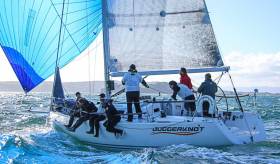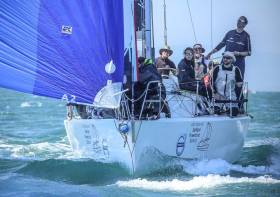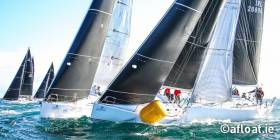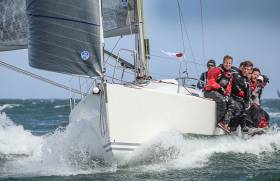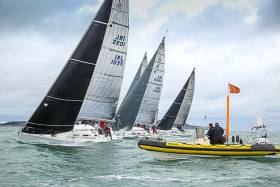Displaying items by tag: J109
How Military Principles Helped the Defence Forces Win in Sailing in 2018
It was while crossing the Atlantic on the Sail Training Brigantine Asgard II during a celestial navigation module of his Naval Service education in 1999 that Barry Byrne had something of an epiphany writes W M Nixon. He’d been introduced to sailing through the welcoming approach of Wicklow Sailing Club in his home town. This led on to joining the Naval Service after he left school.
The thought of transferring to the Army had arisen. Yet it took a long voyage on Asgard II to make the decision for him. His enjoyment of it gave him back his love of sailing and he considered that maybe a career at sea might not be conducive to continuing sailing as a sport.
Thus he changed course, transferring to the Army and a successful career in which he has specialized in technology and served with the UN in peacekeeping missions throughout the world, rising to the rank of Commandant.
In sailing, Barry and his team in the 704-mile Volvo Round Ireland Race 2018 won the Corinthian Class and placed second overall, and then went on to successfully defend the highly competitive Beaufort Cup in Cork Week just two weeks later.
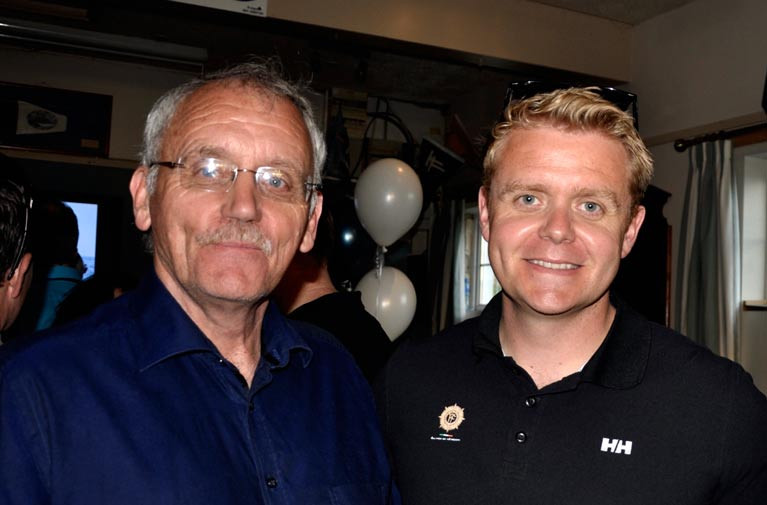 Barry Byrne (right) with his father Shea at Wicklow Sailing Club’s celebration of becoming Mitsubishi Motors “Sailing Club of the Year” 2017. Barry’s captaining of the team which won the inaugural Beaufort Cup in 2016 played a key role in Wicklow SC’s year of achievement. Photo: Angela Higgins
Barry Byrne (right) with his father Shea at Wicklow Sailing Club’s celebration of becoming Mitsubishi Motors “Sailing Club of the Year” 2017. Barry’s captaining of the team which won the inaugural Beaufort Cup in 2016 played a key role in Wicklow SC’s year of achievement. Photo: Angela Higgins
Currently doing an intensive Masters degree in Leadership and Management in the military Staff College at The Curragh, he reflects on how military principles served his team well during last year’s sailing campaign.
While many top sailors achieve success by using proven business administration and motivational means, Commandant Byrne shares the ways in which the success of the J/109 Joker II and her crew might stand up to classic military analysis. He sets the scene:
“Half of the team that competed in the Round Ireland (June 30th) and Cork Week/Beaufort Cup (starting July 16th) had never sailed together before. Like many of us, I had just returned from overseas service with the United Nations in February. We had very little time to put together a campaign aimed at winning two of Ireland’s premier competitions. For this, we used military principles.
Plans are nothing, but planning is everything
General Dwight D Eisenhower is credited with this statement. The point here is that no plan survives first contact with the enemy (or the West Coast of Ireland in a rugged mood). But if you have been through an effective planning process, it will stand to you. We used the Military Decision Making Process (MDMP) and Mission Analysis, essentially breaking down the mission ahead of us by factor, deduction and task. This helped in allocating clear areas of responsibility and job ownership in a short timeframe.
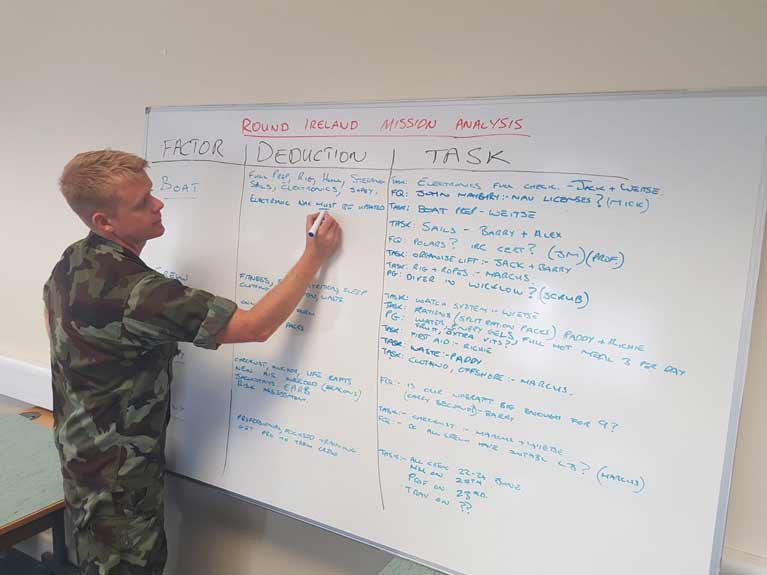 It may seem a long way from racing the Atlantic, but a proper Mission Analysis beforehand set the time-limited preparations on the right trac
It may seem a long way from racing the Atlantic, but a proper Mission Analysis beforehand set the time-limited preparations on the right trac
SMART Goals
The first event was the Volvo Round Ireland, and we set ourselves the goal of winning the inaugural Halpin Trophy, the armed forces trophy introduced by Wicklow Sailing Club. We would be up against international military teams, most notably the semi-professional British Soldier team who had their own race yacht, the X41 British Soldier, which went on to win the RORC annual series. We used the principle of SMART goals, with which many readers will be familiar (Editors' Note: SMART is Specific, Measurable, Attainable, Relevant and Timely). This was an ambitious target, but we assessed it as achievable and it focused our efforts.
Weapon of Choice
There is no point assembling a team if you do not have the tools for the job, and thanks to John Maybury, we had our weapon of choice; the seasoned and very successful J109 Joker 2. John is himself an inspirational leader. He is very supportive of the Defence Forces, indeed some of his own crew of longtime friends have enduring connections to the three services.
Focused Training
The training we completed on Joker2 in such a short time had to be very specific. Every training session had a clearly defined goal and timeframe, and we conducted After Action Reviews following every session. We also enlisted the help of a professional coach, Mark Mansfield, who gave our training focus and direction and was a valuable source of knowledge on J109 rig set up. Mark’s experienced insights on the Cork coastal area were particularly helpful in the Beaufort Cup.
 Mark Mansfield in racing mode. The former Olympic sailor and all-Ireland champion provided valuable insights for the Defence Forces’ crew in intensive training and rig-tuning sessions
Mark Mansfield in racing mode. The former Olympic sailor and all-Ireland champion provided valuable insights for the Defence Forces’ crew in intensive training and rig-tuning sessions
Logistics
Much of the preparation involved getting the boat ready. Getting to the start line of a challenging Cat 3 Offshore Race is a marathon in itself. The safety regulations your boat must pass and the training - such as sea survival - is substantial. Clearly defined areas of responsibility (which emerged from our mission analysis) were key.
One secret weapon we had was Flight Sergeant Adrian Mulligan, an aircraft technician who led much of the boat preparation, particularly regarding instruments. Unfortunately, Adrian suffered a back injury prior to the race. Exemplifying the Defence Forces values of loyalty and selflessness, instead of dropping off the campaign completely, he actually increased his contribution shoreside to compensate for being unable to sail.
 One of the pre-race preparation areas given special attention was nutrition, food and water. The Military Ration Packs may not be some people’s idea of haute cuisine, but they were exactly what was needed.
One of the pre-race preparation areas given special attention was nutrition, food and water. The Military Ration Packs may not be some people’s idea of haute cuisine, but they were exactly what was needed.
He brought another technical member of our race crew, Captain Wietse Buwalda, up to speed with all the instrumentation and power systems on the boat. This was later to prove vital in our success on the water. Other areas we focused on were nutrition, food and water. We had exactly the right amount of high energy military ration pack food, with Sergeant Paddy McGrath and Lt Richie O’Hagan leading the charge here.
Mission command
Another military principle is mission command. You pick the right person for a job and tell them what needs to be done, but not how to do it. A good friend, Captain Mick Liddy, was my navigator just as I had been his navigator on the last Round Ireland we did together. My brief to Mick was to win the Round Ireland… beyond this, I didn’t second guess him.
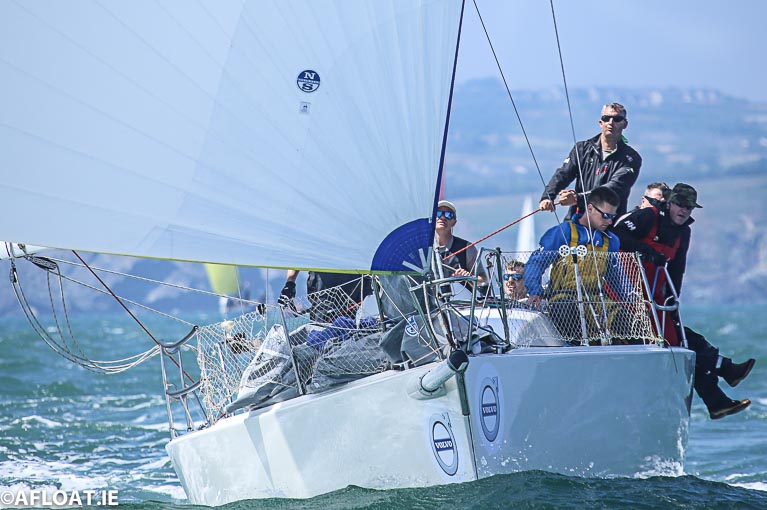 While every crewmember had a primary role, they also took on many other tasks – here, navigator Mick Liddy is on trimming duties shortly after the start.
While every crewmember had a primary role, they also took on many other tasks – here, navigator Mick Liddy is on trimming duties shortly after the start.
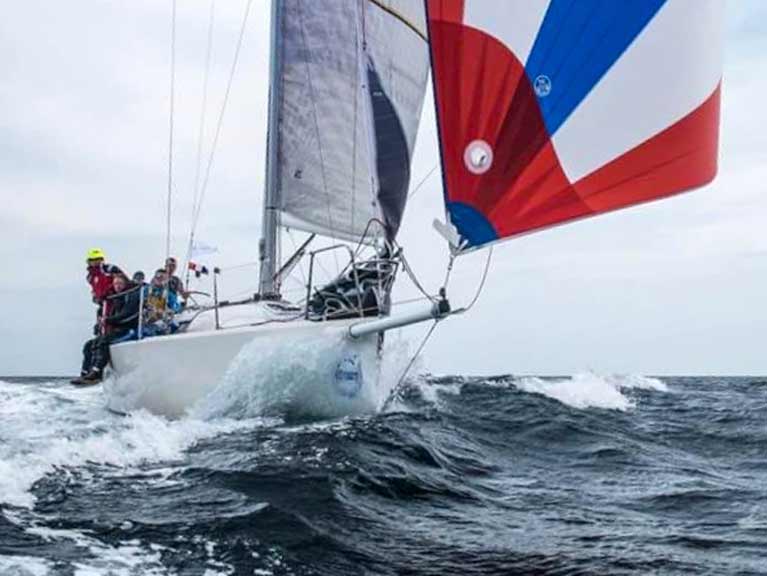 When the going was good. As seen from one of the French competitors, although the sun may not be shining, Joker II is making excellent progress along the south coast.
When the going was good. As seen from one of the French competitors, although the sun may not be shining, Joker II is making excellent progress along the south coast.
When we were off the West Coast in those extremely strong and very persistent north to northeast winds which kick up seas of special viciousness, we were way, way, further West than any other team on the racecourse. Joker 2 was enduring the worst of the weather in the hope of being first to find a suggested slight backing of the breeze. It has to be admitted my resolve was tested, but I’m glad to say I managed to keep my mouth shut. A team in the most recent Volvo Ocean Race fell foul of this inter-personal hazard, with the skipper and navigator second-guessing each other, which ultimately led to an overall slowing down and a harsh lesson for themselves and other offshore campaigners.
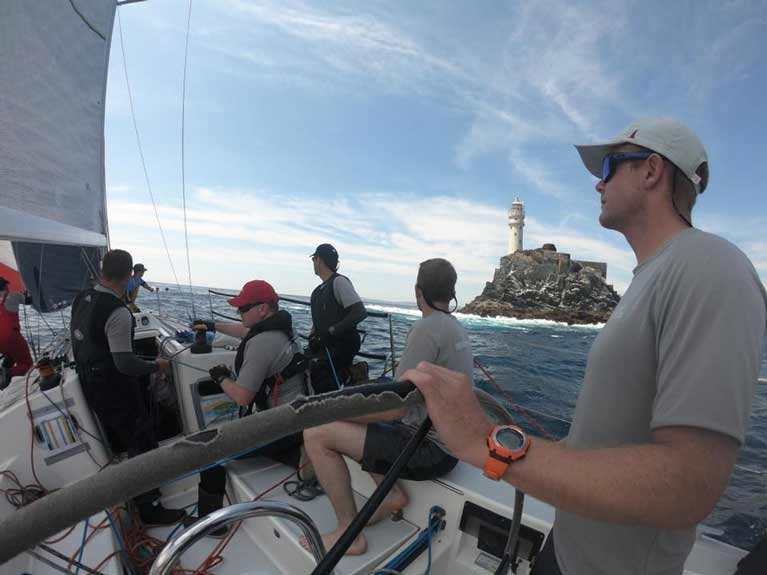 Joker II reaches the Fastnet Rock – the sky may still be blue, but those ominous cloud streaks to the west hint at the fierce headwinds in prospect
Joker II reaches the Fastnet Rock – the sky may still be blue, but those ominous cloud streaks to the west hint at the fierce headwinds in prospect
Values
Our rough-and-then-some experiences far out to the westward further tested other areas of character.
The Defence Forces core values are Respect, Loyalty, Selflessness, Physical Courage, Moral Courage and Integrity. I saw all of these when things got difficult on the West Coast. Due to a sudden diesel leak and the violent conditions, the interior of the boat had become a hellhole and the cause of seasickness among those who had never succumbed before.
Far from strengthening and sustaining ourselves with all those carefully-selected rations, the team could not even keep water down without vomiting, yet everyone dug deep. Mick and I bailed the diesel out of the bilge with a rag and bucket while the boat was slamming into 35 knots of wind. We trusted the team to run the show while the skipper and nav were down there for several hours. My routine was to fill a bucket of sea-watery diesel, empty it over the side, vomit, go back down and fill another bucket. Every member of the crew was a leader that day. Everyone stayed on the rail. Even at 3 am, team members who had not eaten in 30 hours and were continually being drenched to the core with ice cold Atlantic waves, were volunteering to rotate to the bow.
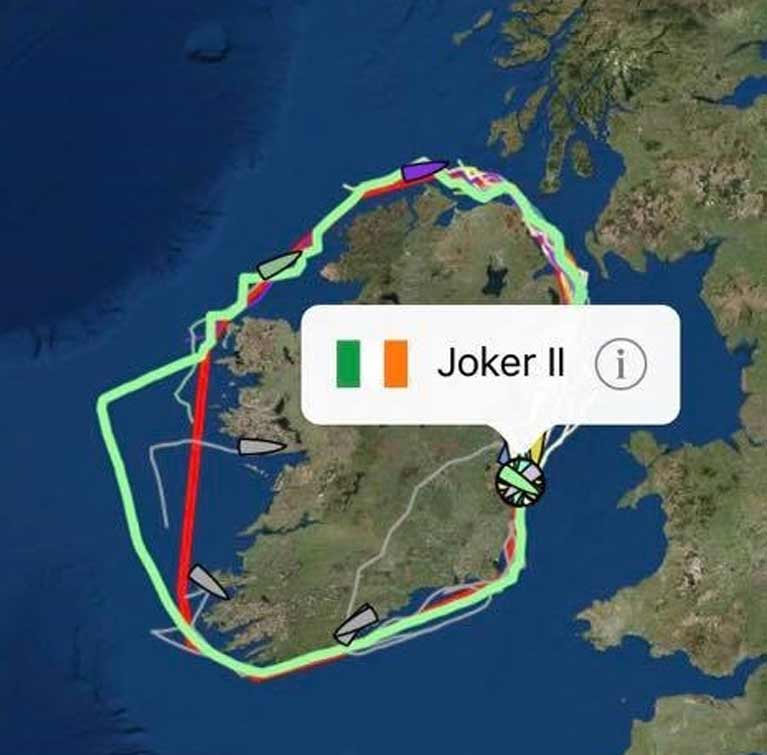 Most crews go off in the Round Ireland Race expecting a fast run down the west coast. But for 2018’s Race, the Atlantic was in a vicious mood with strong to gale northerlies, and Joker II went far to the west in the hope of finding a backing of the breeze suggested by some forecasts. It was a tactic by which they neither gained nor lost, but up off Donegal as the wind slackened, they made some good choices which put them well into the hunt.
Most crews go off in the Round Ireland Race expecting a fast run down the west coast. But for 2018’s Race, the Atlantic was in a vicious mood with strong to gale northerlies, and Joker II went far to the west in the hope of finding a backing of the breeze suggested by some forecasts. It was a tactic by which they neither gained nor lost, but up off Donegal as the wind slackened, they made some good choices which put them well into the hunt.
It was a brutal two nights. Just a few miles from us, a crew had rescued one of their team who had gone overboard in pitch black horrific conditions. (Editor’s Note: In the stream of information coming through from the Round Ireland fleet, the J/109 Jedi, skippered by Michael Boyd with Kenneth Rumball of Irish National Sailing School as first mate, tersely reported an MOB situation. But very quickly, they followed it with a brief message to the effect that the man overboard was retrieved, there were no injuries, and they were immediately resuming the race. This calm approach was so redolent of the best traditions of offshore racing that the incident became just one of many in a tough race. But happily at the RORC Annual Prize Giving in London in November, that briefly-recorded achievement in the Atlantic received the special recognition it deserved, with Michael Boyd and Kenneth Rumball being awarded the RORC’s Seamanship Trophy).
Barry Byrne continues: While this kind of offshore sailing may sound grim, even dangerous, it is precisely why we do adventurous training in the military; to test leaders at all levels.
My dad always says there are no atheists in a foxhole. I don’t think there was an atheist on Joker 2 that night either. Not when we were in the thick of it, nor when we eventually converged with the fleet off northwest Mayo and checked to see where we had ended up in the rankings. Once we’d crossed Donegal Bay, our navigator continued to resist the temptation to hug the coast, and we were looking good approaching Tory Island.
The Final Stages
When the wind eventually eased, it did the worst possible thing - it died completely. Teams were left in tortuous drifting conditions off the North Coast of Ireland where tides would frequently send you backwards at five knots if local seabed conditions or sheer depth of water prevented kedging.
During this particularly trying time, our electronic instruments died completely, thanks to having taken such a hammering off the West Coast. But Captain Wietse Buwalda, a communications officer, who - as mentioned already - had closely studied the electronic systems with Flight Sergeant Adrian Mulligan prior to the race, effectively rebuilt the system in about four hours of relentless work.
 When it all started to come right – having finally escaped from the North Coast, Joker II makes good progress down the Irish Sea
When it all started to come right – having finally escaped from the North Coast, Joker II makes good progress down the Irish Sea
As all this went on, a minke whale followed our boat for about 24 hours. I’m not sure if we were delirious with tiredness, but superstition got the better of us, and we took to sacrificing our tastiest treats from our ration packs to Minkie in the hope he would send some wind…
 One of the most difficult stages was the final 15 miles, with the wind drawing ahead and total concentration needed to get the best out of the boat
One of the most difficult stages was the final 15 miles, with the wind drawing ahead and total concentration needed to get the best out of the boat
And - eventually – he did. We escaped the North Coast with a great spin down the East Coast in twenty knots of favourable breeze. But about fifteen miles from the finish line, we encountered yet more drifting conditions and a nail-biting finish after five days of nonstop racing and minimal sleep. Finally, we got there. The legendary welcome in the wonderful Wicklow Sailing Club was everything I had remembered in previous races.
The fact that we collected the Halpin Trophy meant Mission Accomplished, so it was icing on the cake to get first in the Corinthian Division, first Irish boat and place second overall, in all coming first in four divisions of the 56-strong international fleet of the Volvo Round Ireland Race 2018.
 Military principles and values achieve the desired result
Military principles and values achieve the desired result
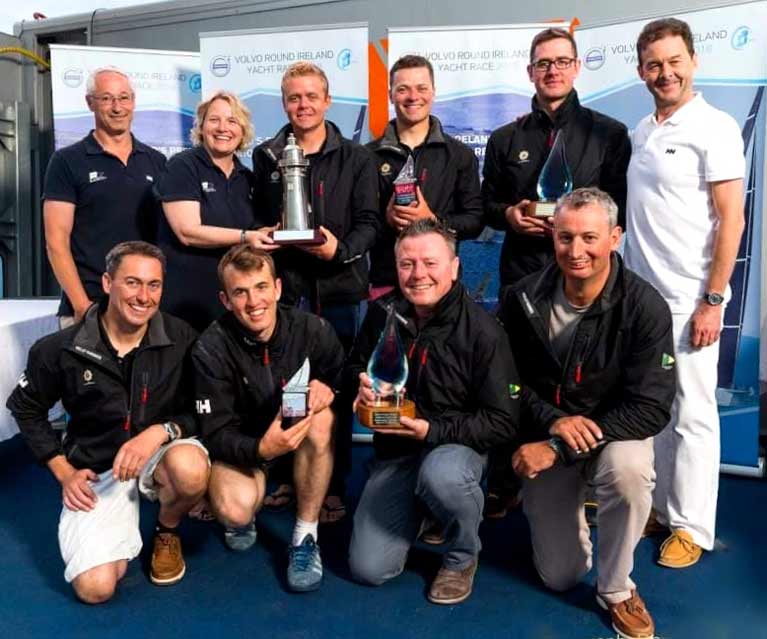 Prize-giving for Joker 2 at Wicklow at the conclusion of the Volvo Round Ireland Race with (back row, left to right) Hal Fitzgerald (Race Director), Denise Cummins (Commodore Wicklow SC), Commandant Barry Byrne, Lt. Alexander Rumball, Capt. Wietse Buwalda and David Thomas of Volvo Car Ireland. Front row (l to r) Cdr Brian Mathews (Commodore Defence Forces SC), Ens. Marcus Ryan, Sgt. Patrick McGrath, and Capt Mick Liddy (Rtd).
Prize-giving for Joker 2 at Wicklow at the conclusion of the Volvo Round Ireland Race with (back row, left to right) Hal Fitzgerald (Race Director), Denise Cummins (Commodore Wicklow SC), Commandant Barry Byrne, Lt. Alexander Rumball, Capt. Wietse Buwalda and David Thomas of Volvo Car Ireland. Front row (l to r) Cdr Brian Mathews (Commodore Defence Forces SC), Ens. Marcus Ryan, Sgt. Patrick McGrath, and Capt Mick Liddy (Rtd).
Beaufort Cup
It was a hectic turnaround to get the boat ready for the Beaufort Cup in Cork just two weeks later. This was made even busier as I am involved with running the series itself and liaising with all the visiting teams. This was the second iteration of the event, and it was a huge success, involving 160 competitors and 30 Defence Forces sailors, making up 16 teams including the US Marines, UK armed forces and Irish emergency services teams including national champions and Olympians, with eight of the 16 boats being highly competitive J109s.
Central to the Beaufort race programme is the short offshore to the Fastnet Rock, a scenic 24-hour drag race down and back. We didn’t manage to get the lead until the last three hours. Until then, we had been schooled from ahead at different times by Simon Coveney, Stefan Hyde, Youen Jacob, Peter O’Leary and Fastnet expert Tim Goodbody.
However, we’d had a solid night race and our navigator Comdt. Ian Travers made a good decision to split from the pack and go offshore for breeze in the final miles. It was a winning move. My brother Teddy had raced with us for this offshore, and it was a great moment crossing the finish line.
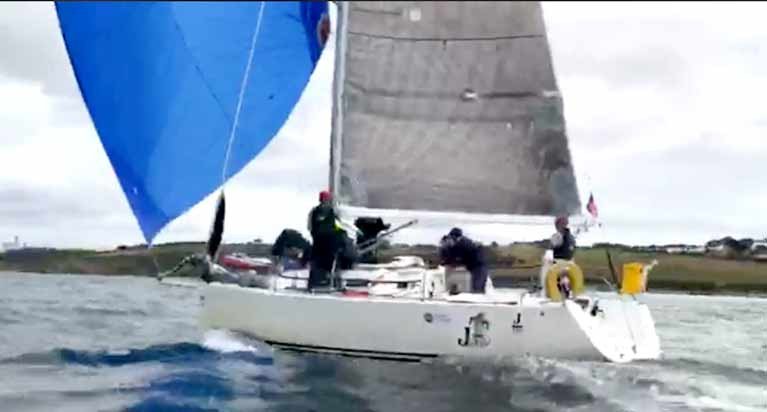 After a spot-on tactical call over the final few miles. Joker 2 sweeps across the lines to win the Fastnet Race in the Beaufort Cup series in Volvo Cork Week.
After a spot-on tactical call over the final few miles. Joker 2 sweeps across the lines to win the Fastnet Race in the Beaufort Cup series in Volvo Cork Week.
The rest of the week was a tough battle, particularly the last race when we were over the start line and had to go back and re-cross the line in a double points race. But yet again, in adversity true teamwork came into its own. Huge performances were put in by the whole team, notably Ensign Marcus Ryan and Louis Malloy sailing a flawless race to get us back into the fifth position we needed to secure overall victory in the event.”
A €10,000 prize goes to the winning Beaufort Cup team, and we gave €5,000 of this to Crumlin Children’s Hospital in Dublin, while the other €5,000 went to the RNLI, something special for us as the Baltimore RNLI crew skippered by Youen Jacob had run us a very close second in the overall series in Cork.
In summary, military tools for campaign planning combined with values of teamwork and resilience stood to the Defence Forces sailing team throughout last year’s ambitious campaign”.
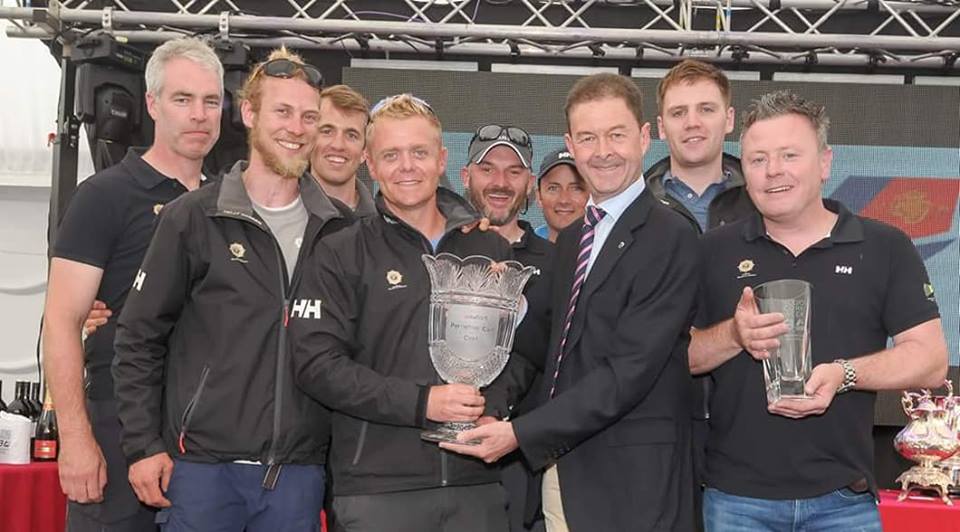 Mission accomplished. Joker II’s team with the Beaufort Cup include (left to right) Cpl. Brian Phelan (Rtd), Louis Malloy, Ens. Marcus Ryan, Commandant Barry Byrne, Malcolm Moir, Capt. Ian Travers (Rtd), David Thomas of Volvo Car Ireland, Lt. Richie O’Hagan, and Sgt Patrick McGrath
Mission accomplished. Joker II’s team with the Beaufort Cup include (left to right) Cpl. Brian Phelan (Rtd), Louis Malloy, Ens. Marcus Ryan, Commandant Barry Byrne, Malcolm Moir, Capt. Ian Travers (Rtd), David Thomas of Volvo Car Ireland, Lt. Richie O’Hagan, and Sgt Patrick McGrath
J109 Champion 'Juggerknot' For Sale
The Irish Championship winning J109 Juggerknot campaigned so successfully last season by Andrew Algeo of the Royal Irish Yacht Club on Dublin Bay is up for sale.
The boat is offered for sale at €99,000 Tax Paid or US$ 114,355
Juggerknot has had two owners from new and has benefited from extensive updates and additions in her current ownership throughout 2017 and 2018.
As previously reported by Afloat.ie, results last season include the Irish J/109 National championship title 2018, Wave Regatta Howth 2018 1st overall IRC1, Irish J/109 Easterns Champions, local club regatta and club racing wins.
According to a brokerage advert posted online here, "the boat presents a great opportunity to own a young and well maintained J/109 with proven success on the race circuit and a very substantial and fresh suit of sails".
On the 29th of June 2018, Jedi, the highly competitive J109, started the Round Ireland Yacht Race in stunning sunshine and a fresh northerly breeze propelling her down the East coast of Ireland.
Little did her seasoned crew comprising of Michael Boyd (Skipper), Kenneth Rumball, James Gunn, John White, Philip Connor, Lorcan Tighe, Kylie McMillan and Diarmud McLaughlin would have in store for them some days later.
At 1 am on the 2nd of July 2018 just South West of the Blasket Islands, well reefed down in 30-35kts of a Northerly breeze, crew member John White was swept overboard.
"Crew member John White was swept overboard"
You can hear the story of how Jedi’s crew dealt with the situation and successfully recovered John back on board within minutes and most importantly the lessons learnt from the incident.
Kenneth, John and members of the crew will be giving two talks and all are welcome, with each club offering donations to different charities.
- Wicklow Sailing Club 1930hrs on the 12th January 2018 donations to Wicklow Hospice, food and refreshments available from 1830hrs.
- Royal Irish Yacht Club 1930hrs on 7th of February with Sailing Supper Afterwards, bookings with [email protected]
UK Sailmakers J109 Class 'Fluid Structure Interaction' Test Report
In Grand Prix classes throughout the sport of sailing, it is well known that sheeting angles are becoming tighter and tighter – modern TP52s have jib sheeting angles as close as 4 degrees off the centreline. The J109 class in Ireland is a growing and competitive fleet so we felt it necessary to take a fresh look at the sail plan and systems aboard the now nearly fifteen-year-old design with an aim to improving performance.
The J109 have evolved significantly over the past fourteen years. The most visible change has been the shift to a non-overlapping jib setup for optimum IRC performance. This shift in sailplan has a significant effect on the boat’s light air performance due the headsail area reduction.
To compensate for this reduction in power the class uses an inhauling system – this narrows the slot between the mainsail and headsail, in turn increasing the power of the entire sail plan. Up until now the common inhaul point has been the edge of the coach roof – approximately 9° sheeting angle. This is effective in true wind speeds of 15 knots and above – but below this the boat is still relatively starved for power when compared to their genoa flying predecessors – we believe further performance is attainable.
During the winter of 2018 UK Sailmakers Ireland, in conjunction with Pat Considine of UK Sailmakers Chicago, carried out a Fluid-Structure Interaction (FSI) test cycle to determine the effectiveness of jib inhauling to a sheeting angle of 6° - just inside the halyard turning blocks on a standard J109.
It quickly became clear that simply raising the clew of an existing sail and inhauling it harder will not produce a driving force gain. In fact inhauling this hard with a standard jib actually slows the boat below the base lines numbers from the initial set up test. A new design approach is required.
Below we detail the process of an FSI study – and present some of our findings and results.
The Process – Simplified
For the purposes of this article we have simplified the FSI testing process to a number of high level steps.
Target Conditions and Baseline Polars
We decided on a specific set of conditions in which we believed our inhauled setup would perform best – this is 10-12 knots in a flat sea-state. These conditions would allow an amateur helm to steer to the tighter sheeting angle without dropping out of the groove.
With our target weather conditions decided we now gather and input our J109 polar data for the test case. Variables include, but are not limited to, heel angle, leeway, boat speed, wind direction etc.
Design
With our target conditions determined and our polars set we now move on to the design phase.
Our standard J109 class mainsail design is used throughout the testing process – this is consistent and does not change.
As we believe this is a specialised light wind sail we begin with a J1 mould for the jib. Deeper than the standard J109 class jib, which is a crossover between a J1 and J2, the new design is deep with twist for power in light airs.
Initial Setup and Setting the Baseline
With our sail designs selected, we now virtually configure our J109 for sailing in the 10-12 knot conditions present in our test case.
We set the rake, mast bend, sheet tension, halyard tension, outhaul, jib car position, backstay tension etc until we reach the optimum settings –producing the maximum amount of lift for the least amount of drag. To get to this optimum setting requires an iterative process of adjusting, testing, re-adjusting, re-testing etc. This is where the skill and experience of the designer really come in to play to reach the fastest setting possible.
One of the key things in this phase of testing was to set the inhauler so the clew our J1 jib to be touching the coach roof coaming of the cabin top. This places the jib at a sheeting angle of 9° from the centreline.
In this phase, we are looking for performance trends. As we make changes and re-test we expect the trend to be positive – either an increase in lift, or a reduction in drag, both leading to positive outcomes. Once the trend begins to plateau or even turn negative we know we have reached the optimum trim for this particular design.
Once the designer can no longer improve the virtual performance of the boat by adjusting sail controls the iterative process stops. A series of comprehensive FSI runs are then done on this setup to provide a baseline set of data to compare and contrast the next round of test against.
Design Iteration
We now implement our suggested improvements to our J1 jib design. Our aim is to sheet this sail at an angle of 6° from the centreline of the boat – this is just inside the halyard leading blocks of the standard J109 deck layout. We will call our new design the ‘JX’ headsail.
Sheeting to a 6° angle, with no change in jib design, causes the slot of the sail plan to close and driving force to be lost due to increased drag. Simply raising the clew of an existing sail and inhauling it harder will not produce a driving force gain. In fact inhauling this hard with a standard jib actually slows the boat below the base lines numbers from the initial set up test. A new design approach is required.
Design Twist
When a sailor hears twist he or she usually thinks of easing the sheet to induce it. What many sailors don’t realise is that there is twist designed into the shape of every sail – they are made to sail with an optimum amount of twist. For example the standard mainsail design twist is approximately 12°.
Returning to our testing we begin to increase the amount of design twist in our ‘JX’ headsail. As the design twist increases drag reduces, and driving force increases. While adjusting the design twist the virtual trim of the jib is also adjusted to keep the sail trimmed optimally.
Once we see the lift/drag/driving force trend begin to plateau we reach optimum design twist.
 Figure 1 - Vertical distribution of twist
Figure 1 - Vertical distribution of twist
We settle on a maximum of 7.6° increase in design twist distributed vertically. This allows the sail to maintain a consistent twist relationship with the mainsail at the smaller sheeting angle of 6°.
Max Camber Position
When inhauling at tight angles it is very important not to ‘shut’ the slot with a return off the headsail leech. A leech hook or return at such tight sheeting angles causes an enormous amount of drag while also clogging up the slot. A straight exit off the leech is needed. A leech hook or return is often cause by the depth of the headsail moving aft towards the leech. This causes the entry to become fine and the leech to close in towards the mainsail – keeping the max camber position forward in the sail is essential.
 Figure 2 - Max camber position
Figure 2 - Max camber position
As we have increased our design twist and brought our sheeting angle well in board we now adjust the max camber position of the sail. Over several iterations we found a gain in moving the max camber position forward. This prevents the upper sections of the headsail shutting the slot.
Camber
Several camber adjustments were made in order to keep the straight exit from the leech of the sail. Notably a reduction in aft camber in the sail’s lower sections.
 Figure 3 - Aft camber adjustments
Figure 3 - Aft camber adjustments
As a result, the overall camber in the lower sections of the sail was also reduced. These flatter sections ensure a straight leech exit at maximum inhauling. The lower depth is now controlled by the positioning of the trim point ie the clew position controlled by the trimmer.
This allows a narrower sheeting angle without an increase in mainsail backwinding.
Results - Comparison to the Baseline
Having iterated over our ‘JX’ design for many hours we settle on the new design. We run the same comprehensive set of FSI tests as were run to provide our baseline set of figures. Below we go through some of our findings.
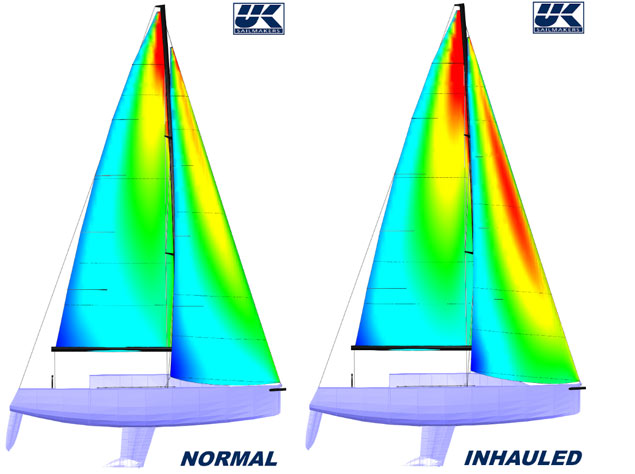 Pressure map comparison
Pressure map comparison
Above you can see our J109 test platform. The left picture is our baseline J1 headsail design. To the right is our new ‘JX’ headsail design. This picture is a leeward view of the sails’ pressure mapping. It can be clearly seen that the ‘JX’ design produces a significant increase in pressure differential when compared to the J1 design.
Not only is there a pressure differential change on the headsail itself but also on the mainsail. This shows how harder inhauling can improve the effectiveness and efficiency of the entire sail plan.
Lift, Drag, and Driving Force
In our FSI testing runs the sail plan is trimmed for proper flow across the luff in 12 knots true wind speed at 37.5° true wind angle. Boat speed of 6.34 knots with 18.8 degrees of heel and 3 degrees of leeway.
Mainsail shape and trim remains constant throughout testing in order to isolate the jib design adjustments.
 Figure 5 - Baseline performance numbers
Figure 5 - Baseline performance numbers
Our initial FSI testing provided some baseline numbers for our new design testing.
Numbers of note:
- Fx (Driving Force): 1154N
- Fz (Side Force): 3770N
- Cl (Lift): 2.77
- Cd (Drag): 0.247
Our subsequent FSI testing runs provided a set of numbers for our new ‘JX’ design. Notable numbers below with deltas from previous testing highlighted in green and red for positive and negative changes accordingly.
 Figure 6 - 'JX' headsail performance numbers
Figure 6 - 'JX' headsail performance numbers
- Fx (Driving Force): 1160N (+1%)
- Fz (Side Force): 3848N (+2%)
- Cl (Lift): 2.79 (+1%)
- Cd (Drag): 0.266 (+7.6%)
With the new ‘JX’ design we are able to achieve a 1% increase in driving force and a 1% increase in lift coefficient of the sail plan.
There is, of course, the associated increase in drag and heeling moment but in 12 knots of true wind speed these can be overcome by righting moment – hike harder.
The other option is to turn the increased lift into height instead of fast forward.
At a true wind angle of 36.5° we maintain the same total coefficient of lift but lose some driving force as a result.
This shows the versatility of the ‘JX’ design. More power and efficiency in normal mode and still very efficient in height mode.
 Figure 7 - 'JX' headsail height mode performance numbers
Figure 7 - 'JX' headsail height mode performance numbers
Mainsail
It must be noted that the mainsail trim was not altered between FSI tests. In reality when at a smaller sheeting angle the mainsail would be brought further to windward to maintain the open slot. This would produce an increase in lift coefficient, side force, and drag. All of which could be overcome by more hiking.
As we all know in this wind speed – whoever gets their crew hiking fully first usually wins.
From Virtual to Real World
In April 2018 UK Sailmakers Ireland’s Barry Hayes, Graham Curran, and Mark Mansfield carried out a two-boat testing session with the newly developed ‘JX’ headsail design as reported by Afloat.ie here.
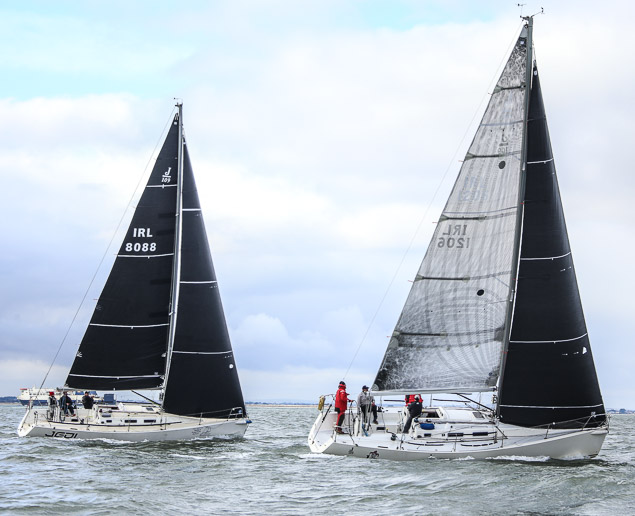 Figure 8 - Two boat testing on Dun Laoghaire Bay
Figure 8 - Two boat testing on Dun Laoghaire Bay
We used two well-matched J109s, including the reigning Irish Class and IRC National Champion “Joker II”.
The test was carried out in ideal conditions with 10-12 knots true wind speed and flat water on Dublin’s Dun Laoghaire bay.
The ‘JX’ headsail was used on both boats throughout testing – with the Joker II’s Championship winning headsail being swapped also. “JEDI” was using a UK Sailmaker’s Uni-Titanium mainsail while “Joker II” was using her own class mainsail.
Several hours we spent upwind testing – lining up bow to bow in the same breeze.
There was a notable difference between the two headsail when both were inhauled hard to a 6° sheeting angle. The ‘JX’ jib remained twisted and fast while the other jib tended to shut out early and cause excess back winding of both mainsails.
Although hard to determine a conclusive advantage it was noted by both helms, independently, that the boat was easier to helm at the tight 6° sheeting angle using the ‘JX’ headsail.
Material Improvements
The J109 is a 14 year old design – you may ask, why wasn’t this done sooner?
The reality is that the material improvements in sailmaking over the last decade have been immense. No so much in what materials are being used, these are fairly constant, more so how they are combined in cloth technology. UK Sailmakers’ Uni-Titanium cloth allows us to build sails with constant draft, depth, and clean leech exits over a large range of wind conditions. Where Dacron or string sails of old would deform and deepen as wind speed increases; Uni-Titanium remains rigid in its design shape. This is essential to modern sail design, particularly sheeting headsails to narrow angles.
Conclusion
Throughout our FSI testing period, it became clear that at closer sheeting angle would improve the overall performance and efficiency of the J109 sail plan. However, we were not convinced that this would be the case in a real-world situation out of the virtual test box.
After on the water test, and several major regattas and a Round Ireland race, we are happy to conclude that the ‘JX’ headsail development has been a success.
"We are happy to conclude that the ‘JX’ headsail development has been a success"
There is much more to inhauling than you may realise. It is common to think of your headsail independently – but it is just one cog in the machine. The relationship between it and the mainsail, and between the sail plan and the underwater profile of the boat must all be considered – they all combine to produce a force which moves you forward, preferably faster than your opponent. If any of these relationships are out of balance then the entire system will begin to crumble.
What is next?
Our virtual and on-the-water testing produced other potential performance improvements to pursue – we are continuing our investment in the J109 class and sailors will be seeing these developments, and more, on Irish waters throughout the coming months.
Andrew Alego's well–tuned Juggerknot crew have won the J109 National Championships at Howth Yacht Club, denying the pre-event favourite Storm (Pat Kelly) a hat-trick on home waters this afternoon.
Algeo's Royal Irish Yacht Club campaign, that had already earned east coast championship honours back in May, emerged two points clear on 11–points after a keenly fought six race series with one discard. Algeo, a former dinghy and J24 sailor, counted two race wins in his five-race tally.
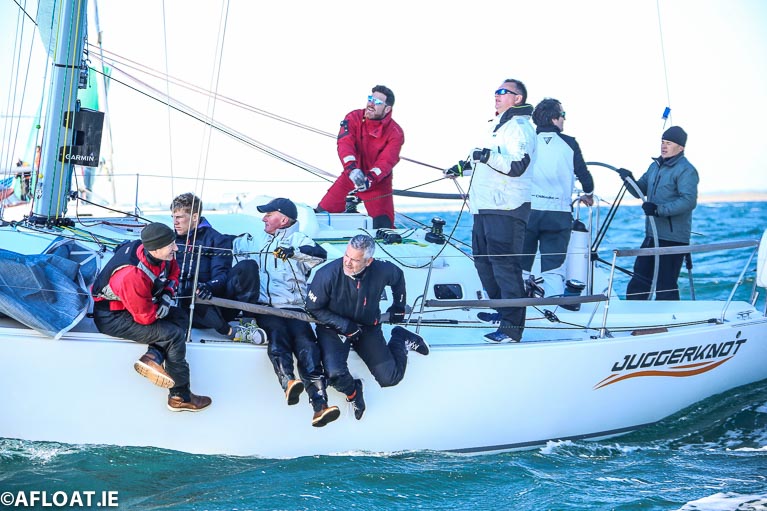 1st - Juggerknot Photo: Afloat.ie and (below) the winning crew at the HYC prizegiving Richard Knatchbull, Shane Conneely, Gary Haughton, Paul Nolan, Ben Cooke, Joe Hughes, Rob O’Leary and Andrew Algeo (with trophy)
1st - Juggerknot Photo: Afloat.ie and (below) the winning crew at the HYC prizegiving Richard Knatchbull, Shane Conneely, Gary Haughton, Paul Nolan, Ben Cooke, Joe Hughes, Rob O’Leary and Andrew Algeo (with trophy)
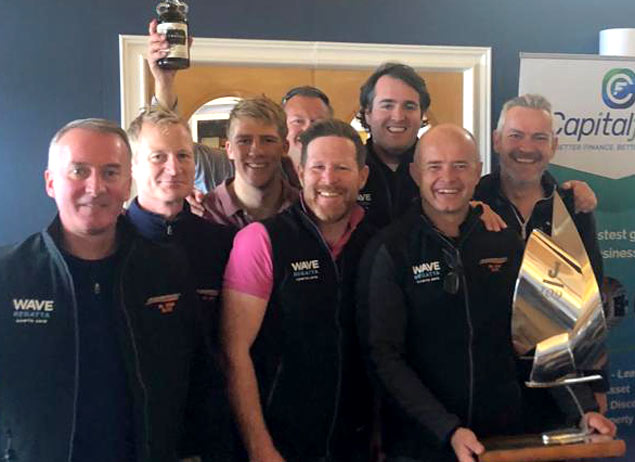
Medium to heavy conditions over two days ideally suited Juggerknot's crew who made the best of the northerly breezes off Lambay with some fine boat handling on display both upwind and downwind.
 2nd - White Mischief Photo: Afloat.ie
2nd - White Mischief Photo: Afloat.ie
Overnight leader Tim Goodbody in White Mischief finished second with a strong one-two result for the Royal Irish Yacht Club.
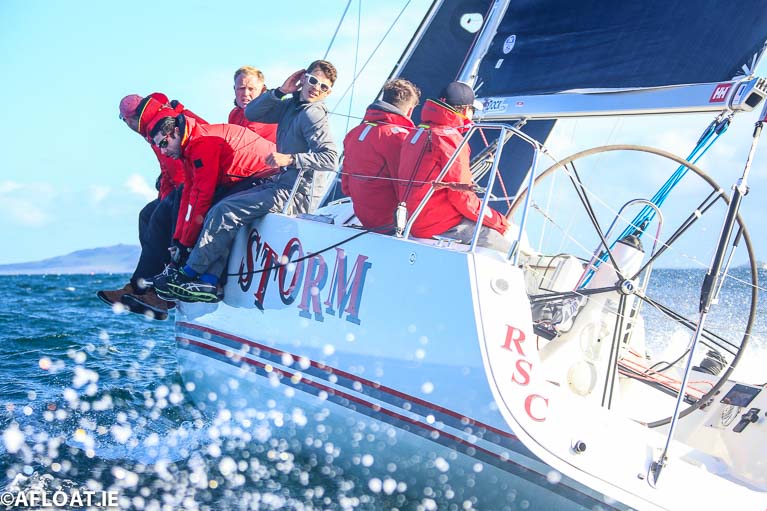 3rd - Storm Photo: Afloat.ie
3rd - Storm Photo: Afloat.ie
The defending champions, Storm, of Howth Yacht Club, finished third overall on home waters on 15-points in the 11-boat fleet.
2018 J109 National Championships Results at Howth Yacht Club:
1st 3660 Juggerknot Algeo, Haughton, Knatchbull, Nolan RIYC 11.00
2nd 1242 White Mischief R & T Goodbody RIYC 13.00
3rd 1141 Storm P Kelly HYC/RSC 15.00
4th 1206 Joker (Jedi) J Maybury RIYC 18.00
5th 5109 Jalapeno Barrington, Despard, O'Sullivan, O'Reilly NYC 19.00
6th 2160 Chimaera A Craig RIYC 21.00
7th 1095 Dear Prudence DP Consortium HYC/RORC/RIYC 30.00
8th 7991 Jigamaree R Harris RIYC 37.00
9th 1383 Ruth Shanahan Family NYC 41.00
10th 1543 Indian Buckley, Knowles HYC 41.00
11th 28898 Powder Monkey Moore, Byrne, Others NYC 60.00
Full scores here
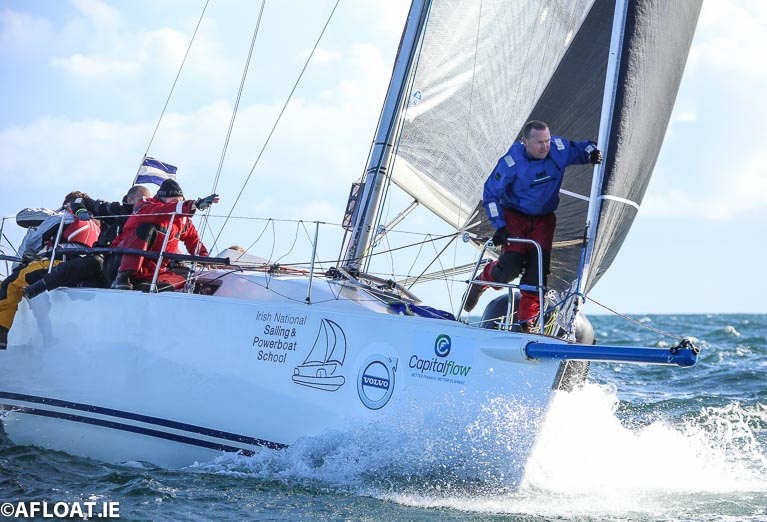 4th - Jedi (Joker II) Photo: Afloat.ie
4th - Jedi (Joker II) Photo: Afloat.ie
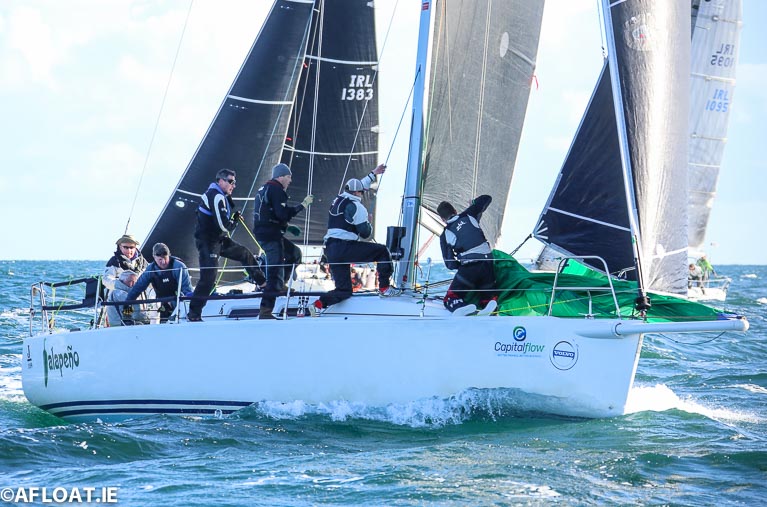 5th - Jalapeno Photo: Afloat.ie
5th - Jalapeno Photo: Afloat.ie
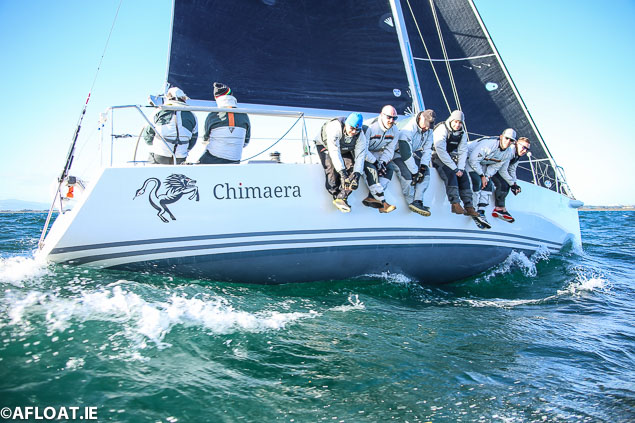 6th - Chimaera Photo: Afloat.ie
6th - Chimaera Photo: Afloat.ie
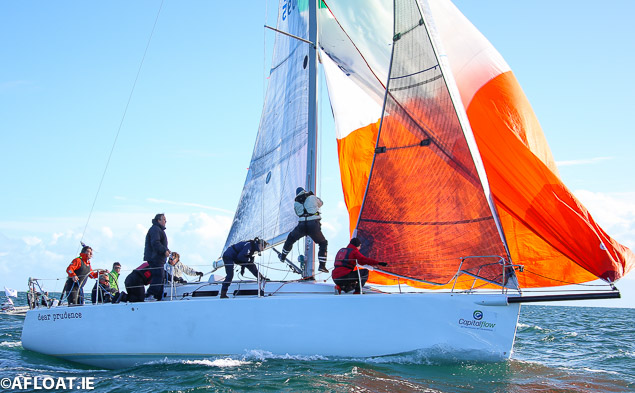 7th – Dear Prudence
7th – Dear Prudence
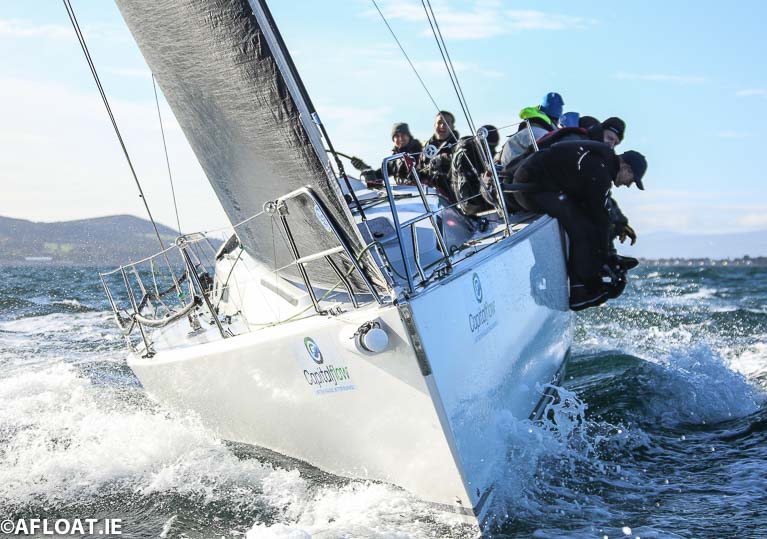 8th - Jigamaree Photo: Afloat.ie
8th - Jigamaree Photo: Afloat.ie
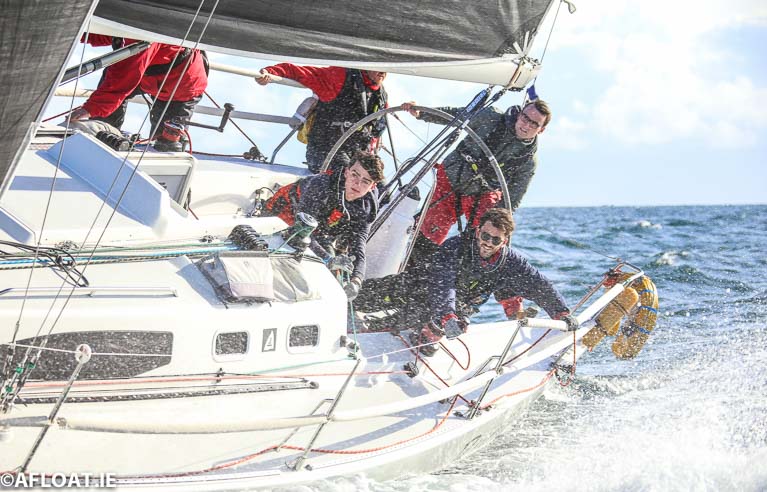 9th – Ruth Photo: Afloat.ie
9th – Ruth Photo: Afloat.ie
 10th – Indian Photo: Afloat.ie
10th – Indian Photo: Afloat.ie
 11th Powder Monkey (File) Photo: Afloat.ie
11th Powder Monkey (File) Photo: Afloat.ie
Dramatic Start to J109 National Championships off Howth
In a dramatic start to today's J109 National Championships at Howth Yacht Club, defending champions, Storm, hit the pin end of the starting line in the first race.
The error meant the Pat Kelly team was in an untypically low place in the 11-boat fleet at the first weather mark on home waters.
Testing conditions put boat handling at a premium in a north-westerly wind of 15–knots and choppy seas just south of Lambay Island.
The Kelly's were quick to recover downwind on the right-hand side of the next run, however. They then worked the left-hand side of the second windward leg to be back into third place by the final beat and keep themselves in contention for a hat-trick victory.
On the water, the race was won by Royal Irish Yacht Club sailor Andrew Algeo in Juggerknot with club mates Andrew Craig in Chimaera second but official results are awaited.
Two more races are scheduled today and a further three races in forecasted stronger breezes tomorrow.
 First on the water - Juggerknot (Andrew Algeo) in top form at the J109 Nationals Photo: Afloat.ie
First on the water - Juggerknot (Andrew Algeo) in top form at the J109 Nationals Photo: Afloat.ie
Will Irish Cruiser-Racing Find Fresh Vitality in the RC35 Class?
The great Danish sailor Paul Elvstrom famously commented that it was much easier to create a completely new racing boat with top class potential than it was to create a successful Class Association with global reach to give proper support to its subsequent development writes W M Nixon.
Elvstrom was not only a sailor of a talent that was at genius level. He was a designer, boat-builder, sailmaker and marine innovator of the highest order, with multiple Olympic Gold Medals and World Championships in his CV. And from time to time, he would bring out a new prototype of the highest quality. Yet seldom did these new boats achieve universal popularity with the ultimate accolade of having an enthusiastic and mostly owner-run international class association.
These thoughts were prompted, in a roundabout way, by consideration of this weekend’s Irish J/109 Nationals at Howth, in which local superstar Storm (Pat Kelly HYC, who’s also of Rush SC) is the defending champion, his crew of Fingal friends – usually augmented by Marty O’Leary - having won a scorcher of a 2017 Nationals at the Royal Irish YC last October.
But in other places, Storm is renowned as the Celtic Cup winner of the relatively new RC35 class. For one of the most interesting things about the J/109 in the Irish scene - and particularly the Dublin Bay context – is that she’s all things to all men and women. Certainly, there are national class associations in several countries and an international association in order to keep the class as One-Design as possible. And in the Dublin Bay group, there are clearly defined crewing rules which prevent boats with the significant professional input of a Category 3 sailor in their crew from taking part in the J/109 Irish Nationals.
 Dublin Bay J/109 racing at top one design level – the annual Nationals are one of the few events where they race as a separate class. Photo Afloat.ie/David O’Brien
Dublin Bay J/109 racing at top one design level – the annual Nationals are one of the few events where they race as a separate class. Photo Afloat.ie/David O’Brien
But nevertheless, flexibility is the keynote of the general approach. Despite the attraction of one-design or semi-one-design racing, the National Championship is one of the few events in which the class in the Greater Dublin area sails specifically as the J/109 Class.
Most of the owners are Dublin Bay Sailing Club stalwarts, and they realise that their class of 15 or so Grand Prix boats make up a significant segment of the upper part of the many and various DBSC cruiser-racer fleet.
This fleet’s turnouts on a Thursday evening are worthy of a detailed sociological study, as many of the crews include people whose only sailing is this one race on a Thursday night, and it has been that way for years. But that’s a kite for flying yet again at another time.
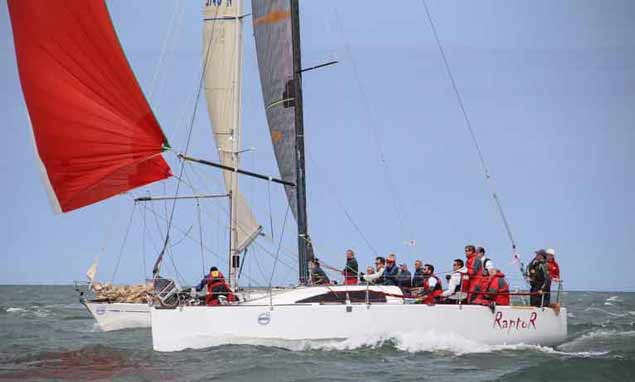 Dublin Bay cruiser-racing is one of the wonders of the Irish sailing scene – and a museum of sailing too. Raptor (Denis Hewitt & partners) may look modern, but she’s a 32ft Mark Mills design of 1996, originally built for Peter Beamish as Aztec
Dublin Bay cruiser-racing is one of the wonders of the Irish sailing scene – and a museum of sailing too. Raptor (Denis Hewitt & partners) may look modern, but she’s a 32ft Mark Mills design of 1996, originally built for Peter Beamish as Aztec
What is relevant is that the J/109 owners realize that if they hived themselves off as a separate class, it would greatly weaken the turnouts in the open divisions. So they prefer to race with their differing IRC ratings as individual boats against each other, and also against boats of other types.
It’s a flexible and mutually-beneficial arrangement which suits the reality of the times we live in. If they were racing as a white-hot and separate One Design class, they’d be under pressure week after week to have a crack crew ready and willing to go, whereas, in the more comfortable space of one of the cruiser-racer divisions, they cut you a bit of slack if frequent turnouts become too onerous.
At least, that’s the way it seems to outsiders. But certainly there’s a different mood to the class when the Irish Nationals are the weekend’s agenda, as they satisfy the need for competitive idealists who dream of a large J/109 one-design class racing week-in, week-out and continually going neck-and-neck in Dublin Bay, whereas realists appreciate that a middle course in class administration produces the most beneficial outcomes.
In achieving this, they work on the J/109’s multi-functional abilities. In a non-One Design context, they were the Boat of Choice in the Beaufort Cup series, the cornerstone of the biennial Cork Week. And the overall winner was John Maybury’s J/109 Joker 2, sailed by Commandant Barry Byrne who, back in June, had also won the Corinthian Division in the Round Ireland Race in the same boat, another feather in the J/109 cap. Then in August some of the J/109s found themselves in Calves Week in West Cork, and after the racing programme was over, owners and their families happily discovered that the J/109 really can be a very effective and comfortable cruiser.
As for the hard-raced Storm, her interests abroad went the opposite way, to the northeast. The Kelly crew have long been successful participants in the Scottish Series in late May, and in 2017 they found themselves involved in a developing Scottish initiative, the RC35 class.
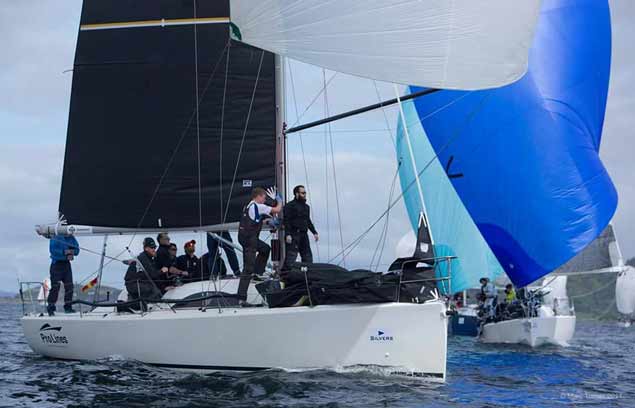 The new RC (Racing Cruiser) 35 Class began to flex its muscles at the Silvers Scottish Series 2017, and the A35 Fool’s Gold (Rob McConnell) from Dunmore East made a mark at this, the class’s national event debut, finishing second overall
The new RC (Racing Cruiser) 35 Class began to flex its muscles at the Silvers Scottish Series 2017, and the A35 Fool’s Gold (Rob McConnell) from Dunmore East made a mark at this, the class’s national event debut, finishing second overall
Sailing in Scotland doesn’t have quite the same rich vein of One Design history which continues to inform much of Dublin Bay racing, and nor does it have the same total single focus which Dun Laoghaire Harbour provides south of the River Liffey, thereby providing continuous interaction among boat-owners.
But in recent years, when the Scottish fleets have got together to race, shrewd and observant participants have noticed that the sport among boats around the 35ft level seemed to have generated its own special popularity, with a sense of community and a high level of competition to match, encouraged by the fact that all boats finished within a reasonably similar time frame.
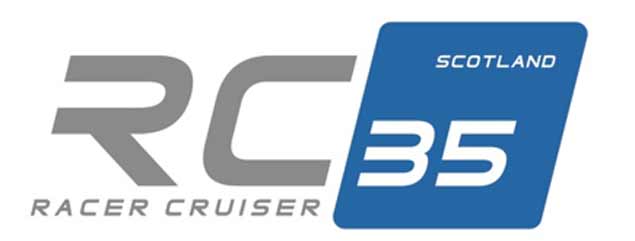 The RC 35 battle flag
The RC 35 battle flag
This was so abundantly evident at 2016’s Scottish Series that by May 2017, folk like John Stamp, Christine Murray, Kevin Aitken and Craig Latimer had hoisted the flag – with the support of Harken and other sponsors - for a new RC35 class for all boats in a tight IRC rating band between 1.015 and 1.040, but with more flexibility on overall length – your pride-and-joy can be anything from 32ft to 38ft in overall length.
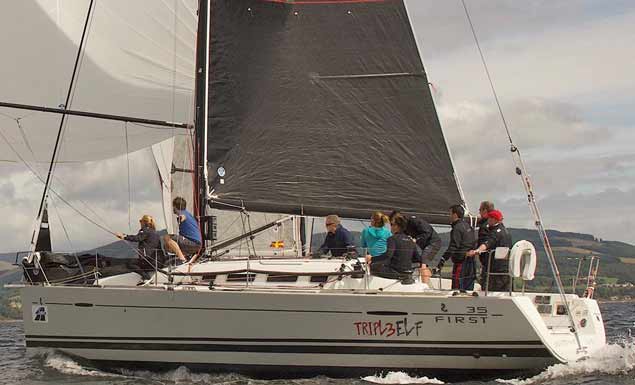 One of the keenest RC35 competitors is the First 35 Triple Elf, owned by Christine Murray who was a founder of the class
One of the keenest RC35 competitors is the First 35 Triple Elf, owned by Christine Murray who was a founder of the class
Like many successful organisational ideas, it wasn’t revolutionary – rather, it rationalised an existing situation to give it a much more attractive and user-friendly structure. Suddenly, lone owners with boats like Beneteau First 36.7s, First 35s, Archambault 35s, Corby 33s, and several Elans and X Boats, found that they were being brought in from the cold to become part of a real warm class with a nascent class association, run by owners for owners with a growing sense of camaraderie. And they’d their own developing programme, where the really keen could commit to the entire season, while others knew they’d have good racing with a welcome guaranteed even if they went to only one regatta.
The J/109s fit very neatly indeed into the lower sector of that tight RC 35 rating band, so by 2017’s Scottish Series, the Irish J/109s found that the IRC 2 Class had also become the RC35 Class, and it fitted them like a glove. Then, by the 2018 Scottish Series, IRC 2 was no more. It was now clearly named the RC35 Class. And the new setup was the best show in town, with the Irish making hay and Storm winning overall by four points from John Hall’s J/109 Something Else from the National YC.
 The closest of class racing for three different bow profiles, as they’re all in RC35.
The closest of class racing for three different bow profiles, as they’re all in RC35.
For Storm, it marked the conclusion of a remarkable month in Scotland which made the Kelly family the Afloat.ie “Sailors of the Month” for May 2018, as they’d been so taken with the RC35 concept from their experience in 2017 that they took part (needless to say with success) in the class in racing at the early May Bank Holiday, and Kip Regatta at mid-month before going on to Tarbert and the Scottish Series.
Then they hastened home for the new Wave Regatta at Howth and though in the J/109s they had to concede first overall to Andrew Algeo and partners in Juggerknot, Storm won the tradition Lambay Race around which the Wave Regatta is centred. For a Fingal boat, the 164-boat Lambay Race in itself is every bit as important as the Wave Regatta overall.
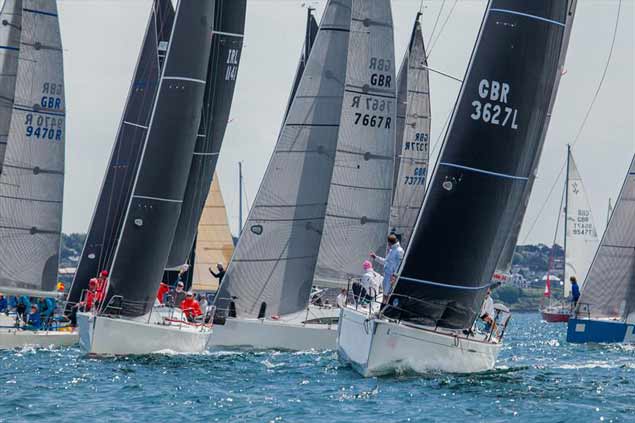 Pre-start jockeying for the RC35s at Bangor Town Regatta on Belfast Lough in July.
Pre-start jockeying for the RC35s at Bangor Town Regatta on Belfast Lough in July.
Meanwhile, up on Belfast Lough the concept of the RC 35 Class had come across the North Channel to be one of the building blocks for the multi-class Bangor Town Regatta in the extended first weekend of July, a new twist on an ancient event jointly organised by Royal Ulster YC and Ballyholme YC. In the end, the relevant class was called IRC 2, but it was the RC35s by any other name, and this time it was a Scottish boat, the Elan 380 Animal (Debbie Aitken) which won, albeit by only one point from Storm in the regatta’s hottest classes.
Back home in Howth in late July, the Kelly family’s efforts were re-directed towards helping tonner Half Tonner Harmony (Johnny Swann) prepare for the Half Ton Classics in Belgium in August, as young David Kelly – Pat’s grandson – is a member of the Harmony crew. Apart from showing the camaraderie of sailing, it was something which underlined the significant difference between Howth’s hyper-keen Half Tonners (we hear the class is soon to have an interesting new addition) and RC35s like the J/109.
For the Half Tonners are a manageable road-trailing proposition, but the J/109s and other RC 35s are too big for most owners to consider the road journey as an integral part of campaigning.
 Different boat types, same class…..A typical RC35 melange at the weather mark
Different boat types, same class…..A typical RC35 melange at the weather mark
In other words, the RC35 has the potential to flourish when its various centres are within reasonable sailing distance of each other, and this is why its initial area of growth is along the Firth of Clyde with out-reach to the East Coast of Ireland and North Wales, with the different main events being given an overall structure through the season-long Celtic Cup Trophy. For 2018, this was decisively taken by Storm after she added to her earlier success in the Clyde and Belfast Lough by winning the Welsh IRC Championship off Pwllheli and Abersoch in breezy conditions in August.
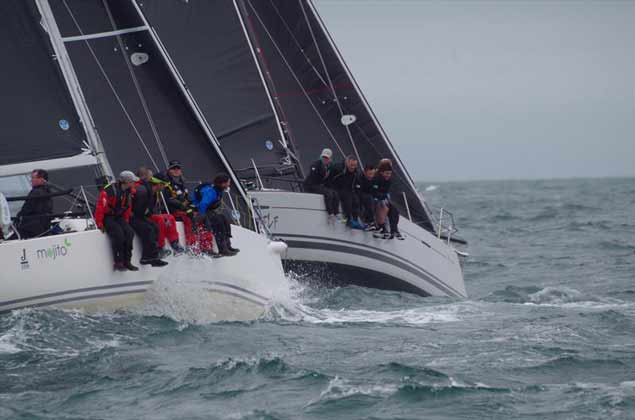 The RC35 Class gets to Wales in August 2018 – ISORA Champion 2017 (and 2018), the J/109 Mojito (Vicky Cox & Peter Dunlop), finds herself drawn into the RC35 class in close contention with Scottish visitor Triple Elf (Christine Murray).
The RC35 Class gets to Wales in August 2018 – ISORA Champion 2017 (and 2018), the J/109 Mojito (Vicky Cox & Peter Dunlop), finds herself drawn into the RC35 class in close contention with Scottish visitor Triple Elf (Christine Murray).
This weekend’s National Championship in Howth is, of course, an exclusively J/109 event, but for next year the RC35 Class are keen to make the Dun Laoghaire Regatta 2019 one of their pillar events. There were preliminary moves back in 2017, but for 2019 all the signs are that the RC35s are going to give the VDLR 2019 the full welly if all the balances between class divisions can be resolved.
Making the cut in rating bands for major cruiser-racer events is now almost a spectator sport. But there’s no doubting that the enthusiastic adherents of the diverse new RC35 class have brought a sense of cohesion, camaraderie and sheer fun in sailing to the sometimes seemingly sedate world of cruiser-racing. This is a truly grassroots movement – there’s no way it’s a stultified top-down organisation. We might say that the market has spoken, and the producers (aka Event Organisers) have to listen.
It’s all a very long way from Paul Elvstrom producing a brilliant new boat and then hoping an active class association takes shape through some sort of natural process...
Andrew Algeo's 'Juggerknot' Crew Thunder to J109 East Coast Victory at Royal Irish Yacht Club
Andrew Alego's powerful Juggerknot crew took their first J109 Championship victory on Dublin Bay today as they swept to a two–point win at the Royal Irish Yacht Club.
Dublin Bay sailor Algeo, of the host club, emerged on top over four races and one discard in the 11–boat fleet, in an event that was previewed by Afloat's W M Nixon here.
Algeo, who has a packed 2018 campaign, beat Howth Yacht Club's Dear Prudence, skippered by Patrick Cruise O'Brien, to win by two clear points and lift the East Coast Championship trophy sponsored by North Sails Ireland.
"The Howth boat broke up a clean sweep of the top five for RIYC boats"
The Howth boat broke up a clean sweep of the top five for RIYC boats with Andrew Craig's Chimaera third and Tim Goodbody's White Mischief fourth.
National champion Joker II (John Maybury) was fifth overall but was forced to retire today with steering failure after winning this morning's first race.
“It’s our first regatta win and we had to climb up a competitive fleet after some poor starts, so we are really delighted", Algeo told Afloat.ie
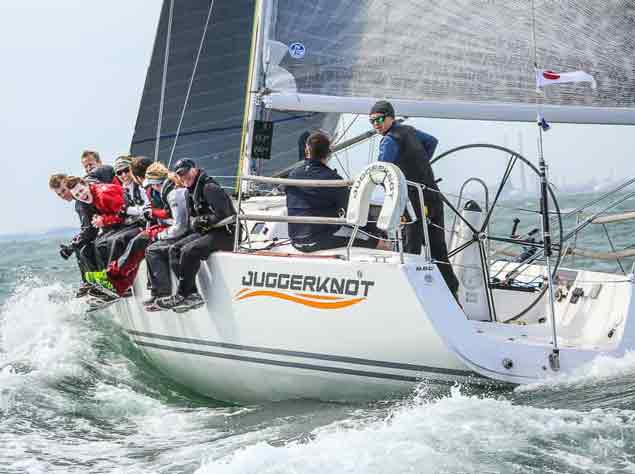
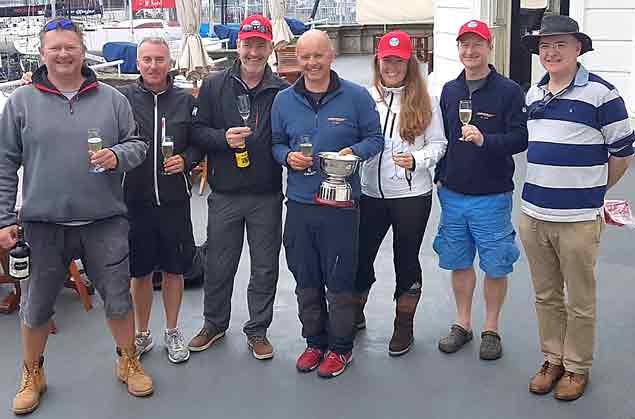 Top and above The Juggerknot crew - Ben Cooke, Gary Haughton, Paul Nolan, Andrew Algeo, Ruth Hite, Richard Knatchbull and David O’Flynn after their J/109 Juggerknot of the Royal Irish YC with the J/109 Eastern Championship trophy
Top and above The Juggerknot crew - Ben Cooke, Gary Haughton, Paul Nolan, Andrew Algeo, Ruth Hite, Richard Knatchbull and David O’Flynn after their J/109 Juggerknot of the Royal Irish YC with the J/109 Eastern Championship trophy
Racing got underway on Saturday in a breezy coastal race on a DBSC course sailed to the Bray outfall buoy in southerly breezes and a big, choppy sea.
Three windward leeward races on Sunday under RIYC Race Officer Henry Leonard gave the fleet slightly lighter winds from the SE ranging in strength from 12–18 knots.
Video by Maurice O'Connell of North Sails Ireland
Full results below
 Patrick Cruise O'Brien's Dear Prudence was second overall after a last race win Photo: Afloat.ie
Patrick Cruise O'Brien's Dear Prudence was second overall after a last race win Photo: Afloat.ie
Next up for Juggerknot is June's Wave Regatta at HYC, then all four of Dun Laoghaire's Club regattas before the RIYC boat heads south for Cork Week and the Beaufort Cup in Cork where Juggerknot will sail under the burgee of Baltimore RNLI as Afloat.ie reported previously here.
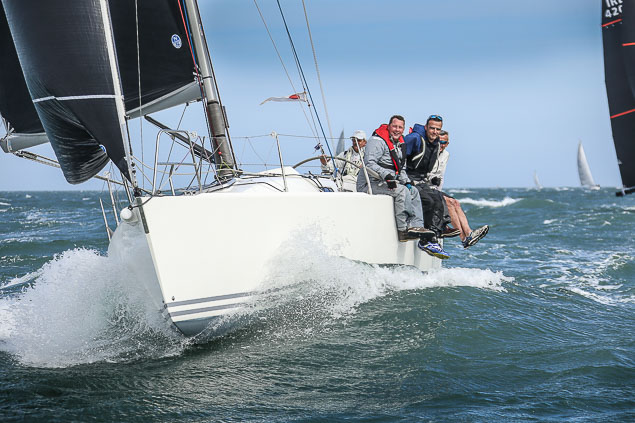 Four results in the top five gave J109 Class Captain Andrew Craig third overall in Chimaera. Photo: Afloat.ie
Four results in the top five gave J109 Class Captain Andrew Craig third overall in Chimaera. Photo: Afloat.ie
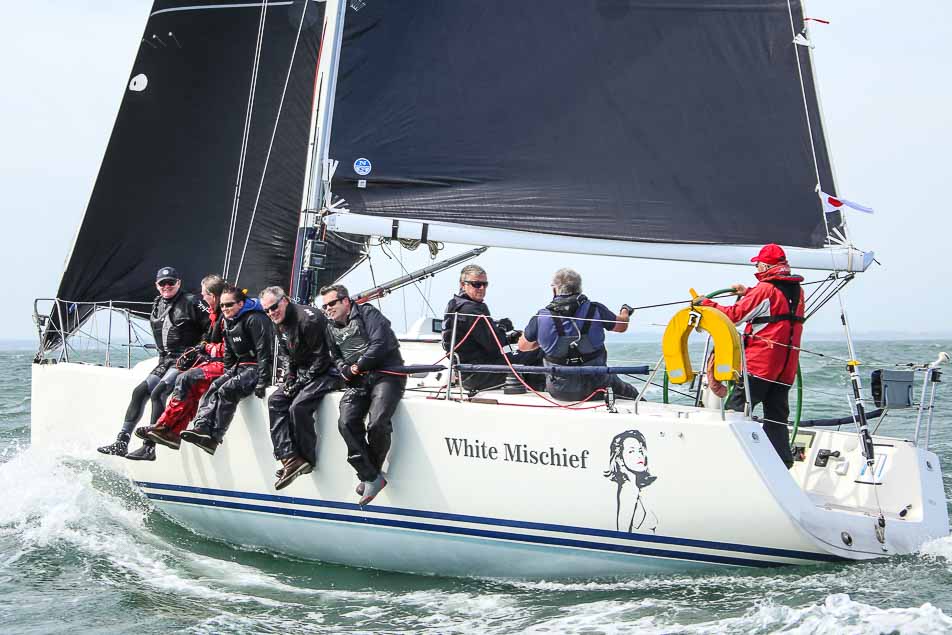 Timothy & Richard Goodbody's White Mischief were winners of Saturday's opening coastal race and finished fourth overall Photo: Afloat.ie
Timothy & Richard Goodbody's White Mischief were winners of Saturday's opening coastal race and finished fourth overall Photo: Afloat.ie
 Poolbeg Yacht and Boat Club J109 Wakey Wakey (Roger Smith) finished sixth overall Photo: Afloat.ie
Poolbeg Yacht and Boat Club J109 Wakey Wakey (Roger Smith) finished sixth overall Photo: Afloat.ie
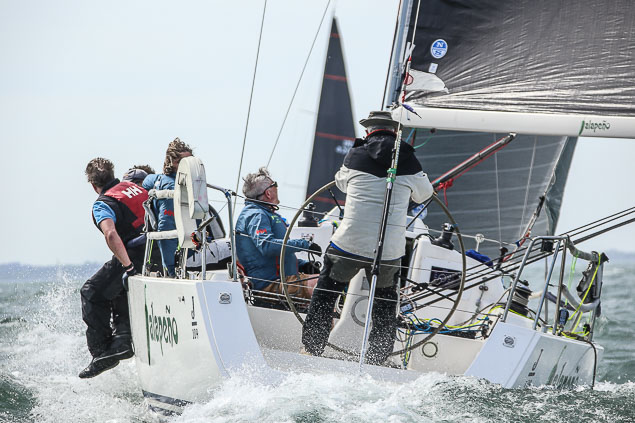 Above and below: The National Yacht Club's Jalapeno skippered by Paul Barrington
Above and below: The National Yacht Club's Jalapeno skippered by Paul Barrington

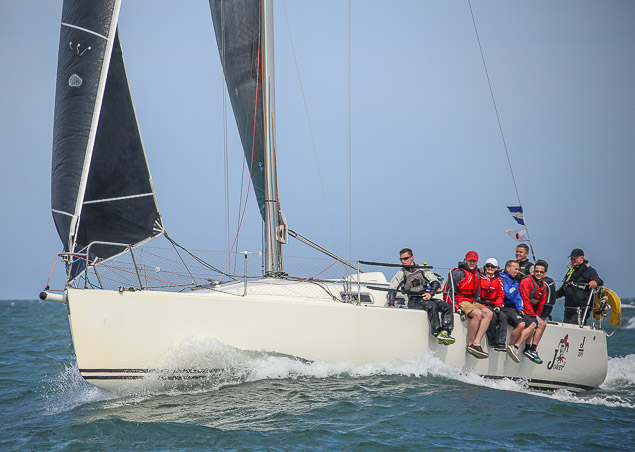 Commandant Barry Byrne of the Irish Defence Forces at the wheel of Joker II. Byrne will skipper Joker II in July's Beaufort Cup in Cork Harbour Photo: Afloat.ie
Commandant Barry Byrne of the Irish Defence Forces at the wheel of Joker II. Byrne will skipper Joker II in July's Beaufort Cup in Cork Harbour Photo: Afloat.ie
J109 North Sails East Coast Championships 2018 Results
|
1 |
3660 |
Juggerknot |
Andrew Algeo |
RIYC |
6 |
2 |
3 |
1 |
4 |
|
2 |
1095 |
Dear prudence |
Patrick Cruise O'Brien |
HYC |
8 |
3 |
7 |
4 |
1 |
|
3 |
2160 |
Chimaera |
Andrew Craig |
RIYC |
8 |
4 |
2 |
2 |
5 |
|
4 |
1242R |
White Mischief |
Timothy & Richard Goodbody |
RIYC |
11 |
1 |
4 |
6 |
12 |
|
5 |
1206 |
Joker 2 |
John Maybury |
RIYC |
12 |
8 |
1 |
3 |
12 |
|
6 |
5909R |
Wakey Wakey |
Roger Smith |
PYBC |
13 |
7 |
5 |
5 |
3 |
|
7 |
1543 |
Indian |
Colm Buckley, Simon Knowles |
HYC |
17 |
9 |
6 |
12 |
2 |
|
8 |
5109 |
Jalapeno |
Paul Barrington |
NYC |
25 |
5 |
8 |
12 |
12 |
|
9 |
1383 |
Ruth |
Shanahan |
NYC |
30 |
6 |
12 |
12 |
12 |
|
10 |
28898 |
Powder monkey |
Chris Moore |
NYC |
31 |
12 |
12 |
7 |
12 |
|
11 |
7991 |
Jigamaree |
Gordon Judge |
RIYC |
31 |
10 |
9 |
12 |
12 |
The vibrant J/109 class in the Greater Dublin area starts its “One Design” season today with the two day Eastern Championship at the Royal Irish Yacht Club in Dun Laoghaire. The class as a One-Design then goes through a busy summer including the Howth Wave Regatta at the beginning of June, eventually completing its programme with the Irish Nationals – again at Howth Yacht Club - on October 6th & 7th.
Between these three pillar events – and indeed before this weekend in the earlier part of the sailing years, and after the Nationals in October – this versatile boat finds a multiplicity of uses as a One Design, as the backbone of Dublin Bay SC Class 1, as an IRC-rated boat sailing under a number of handicap figures, as an ECHO-rated boat if needs be, and as an offshore racer with a proven and continuing record of success. In addition, if you’re so inclined, she can also be a comfortable performance cruiser which is a delight to sail. W M Nixon puts a fresh perspective on a very special boat.
When the hyper-competitive J/109 class puts to sea today from Dun Laoghaire Harbour to start their Eastern Championship with participation in the Dublin Bay SC Coastal Race, they’ll be heirs to a special and continuing tradition of one-design keelboat sailing which goes back 120 years. For it was in 1898 that the legendary Fife-designed Dublin Bay 25 ODs first raced.
 History brought into the modern world. One of the ancient and very impressive silver cups from Scottish sailing history which have found new life as a trophy in Kip Regatta – and for 2018 it was won by Storm from Ireland. Photo: Ronan Kelly
History brought into the modern world. One of the ancient and very impressive silver cups from Scottish sailing history which have found new life as a trophy in Kip Regatta – and for 2018 it was won by Storm from Ireland. Photo: Ronan Kelly
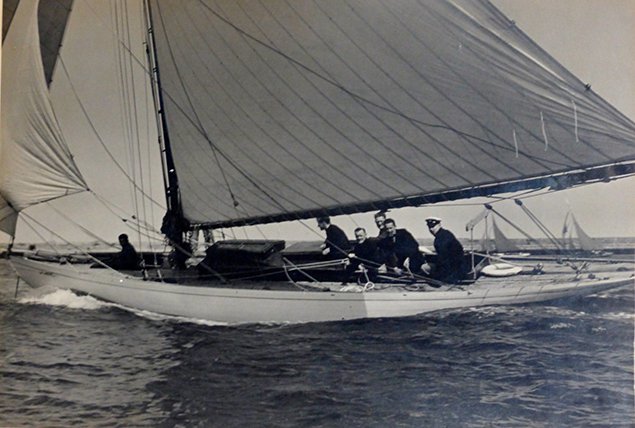 Daddy of them all. The William Fife-designed Dublin Bay 25 Acushla (Pierce and Denis Purcell) racing in Dublin Bay in 1938 when the designs for the new Dublin Bay 24 by Alfred Mylne were already being planned. Photo: courtesy Piece Purcel
Daddy of them all. The William Fife-designed Dublin Bay 25 Acushla (Pierce and Denis Purcell) racing in Dublin Bay in 1938 when the designs for the new Dublin Bay 24 by Alfred Mylne were already being planned. Photo: courtesy Piece Purcel
With their jackyard topsail-setting gaff rig and sporting no less than three headsails, they may have been of a very different appearance to the straightforard sloop-rigged J/109s. But in terms of boat size and purpose, they were broadly similar, and so too were the Bermudan-rigged Dublin Bay 24s which succeeded the old and by now well-worn 25s in 1938.
However, as the order for the DB 24s had been placed with the builders in Scotland just as World War II of 1939-45 broke out, it was 1947 before the class were racing in full trim in Dublin Bay. But my word, once they were active, what superb service they gave in their long class racing careers from 1947 to 2004.
And in a sense, they were more genuinely representative of what the J/109s does now, as they were well capable of fast cruising, As for offshore racing, despite a ferocious RORC rating which penalised their elegantly long overhangs, one of them - Stephen O’Mara’s Zephyra sailed by Arthur Odbert - was overall winner of the very stormy RORC Irish Sea Race of 1963, a real slugfest of more than 200 miles.
 The Dublin Bay 24s competing in leisurely style for their Golden Jubilee Race in 1997. They continued racing in Dublin Bay until 2004, by which time – coincidentally – the new J/109 was being unveiled. Photo: W M Nixon
The Dublin Bay 24s competing in leisurely style for their Golden Jubilee Race in 1997. They continued racing in Dublin Bay until 2004, by which time – coincidentally – the new J/109 was being unveiled. Photo: W M Nixon
Although the DB 24s kept going as a One-Design class through the turn of the Century, there’d been an attempt to replace them in the 1960s with an early similarly-sized totally glassfibre boat, the van de Stadt-designed Excalibur 36. But she proved too utterly and completely plastic for Dublin Bay tastes, and it wasn’t until the elegant yet practical J/Boat range first made its debut in America with the J/24 around 1976 – built by the Johnstone brothers in classic American can-do style in the family garage – that there were real hopes that something might in time appear with the special cachet of the DB 25 and the DB 24.
In the meantime, the Sigma 33 was fine for Dun Laoghaire in its day, but there were too many racing boats bigger and faster then it out on the bay for it to really capture the imagination, even if it upholds the finest Dublin Bay One Design traditions. Yet while the Sigma 33 was very firmly established in premier position for a long period, it took a couple of false starts before the J/109 of 2004 origins began to fulfill its true role as Dublin Bay’s premier One Design class, a position it now occupies with considerable style and a ferocious level of competitiveness.
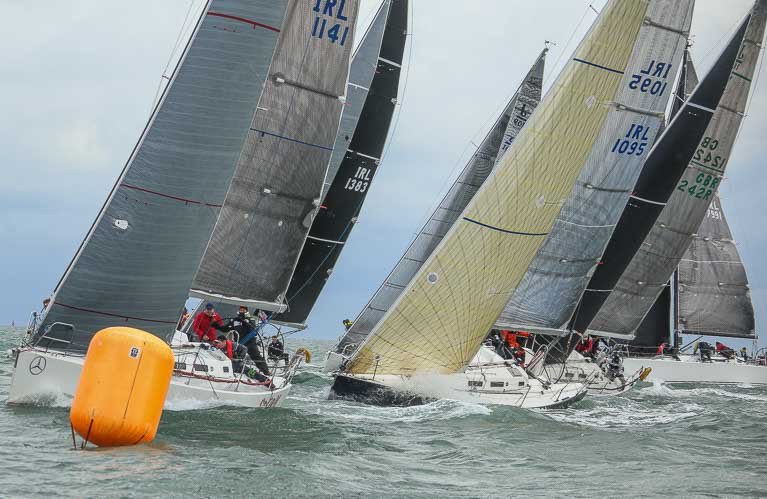 The new style. J/109s in hyper-close competition in Dublin Bay. Photo: Afloat.ie
The new style. J/109s in hyper-close competition in Dublin Bay. Photo: Afloat.ie
So much so, in fact, that leading Cork sailor and former Olympian Mark Mansfield of UK Sailmakers was recently moved to comment that the level of top sailing in Dublin Bay J/109 and Class 1 racing could favourably withstand comparison with the higher echelons of sailing anywhere, a viewpoint which is reinforced by the fact that another top Cork sailor-cum-sailmaker, Maurice “The Prof” O’Connell of North Sails, is so deeply involved that North Sails are sponsoring the J/109 Eastern Championship in Dublin Bay this weekend, and the Nationals at Howth in October.
Competition at this level is reminiscent of the 1930s when the world’s hottest racing was in the International Six Metre class in both the Solent and on Long Island Sound, when it was said at both venues that the likely winner of the next race would be the boat with the newest headsail…
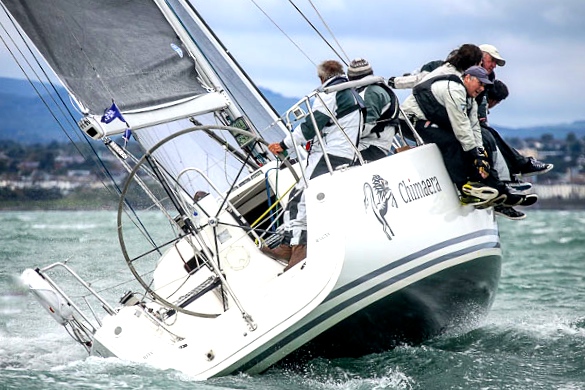 2018 Class Captain Andrew Craig racing Chimaera. Photo: Afloat.ie
2018 Class Captain Andrew Craig racing Chimaera. Photo: Afloat.ie
Certainly this weekend’s racing is expected to see the likes of Andrew Craig in Chimaera, the Goodbody family in White Mischief, and Andrew Algeo in Joggerknot vying for the honours, but unexpectedly there’s a significant absentee – current Irish champion Storm has stayed on in Scotland after collecting some serous silverware at the Kip Regatta over the early May Bank Holiday Weekend.
Originally the hyper-keen Kelly family of Rush had hoped to bring their immaculately-maintained boat home for the Eastern Championship before returning to Scotland to defend the Scottish Series title which made them the Afloat.ie “Sailors of the Month” for May 2017. But logistics are against them as this year’s month of May has only four weekends, so as Storm is going so well in Scottish waters that they’ve decided to keep her there until they return directly from the Scottish Series of May 24th to 27th to be in top form for the Wave Regatta at their home port of Howth from June 1st to 3rd, an event to which the J/109s are firmly committed.
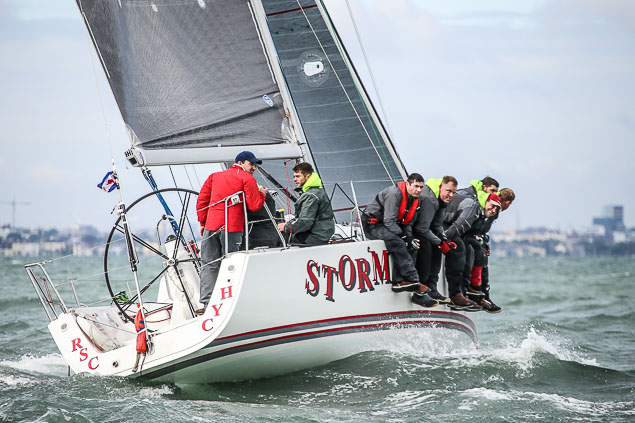 2017 J/109 National Champion Storm on her way to victory. Each winter, the Kelly family give her the highest quality TLC in a shed in Rush. Photo: Afloat.ie
2017 J/109 National Champion Storm on her way to victory. Each winter, the Kelly family give her the highest quality TLC in a shed in Rush. Photo: Afloat.ie
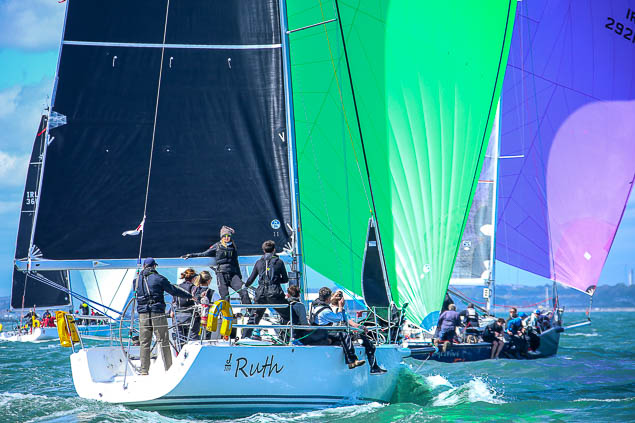 Another winner. The Shanahan family’s J/109 Ruth was overall victor in the 2015 Volvo Dun Laoghaire to Dingle Race. Photo: Afloat.ie
Another winner. The Shanahan family’s J/109 Ruth was overall victor in the 2015 Volvo Dun Laoghaire to Dingle Race. Photo: Afloat.ie
In fact, the level of commitment of the Kelly family themselves is mighty impressive, and it gives us some insight into what goes on behind the scenes through the winter in order to maintain a boat to top racing standard. The Kellys are based in and around Rush in the heart of Fingal, and that very agricultural area is well-blessed in its availability of sheds big enough to accommodate a J/109 through the winter. Thus although she’s a 2008 boat, Storm is as good as new, and Ronan Kelly was telling me that though it took a while to get into the winter maintenance rhythm going this time round, the month of February 2018 became one of exceptional productivity in the shed. So as you observe Storm swanning along in elegant style on a summer’s day, think instead for a moment of a dark and very wintry February night up in the North County, and the voluntary hard work on Storm kept going by camaradarie and commitment.
Yet in talking to Ronan Kelly and any other dedicated J/109 sailor, the underlying impression is the sheer joy they have in finding a boat which so perfectly fits their needs for the best of sailing in their area. For sure there are others who will tell you that if you move up even a little in size and newness in the comprehensive J/Boat range, you might be impressed by the increase in comfort. But then you have to reminder that even modest size increases mean an exponential increase in cost.
 The Irish Sea dimension. Mojito (Vicky Cox and Peter Dunlop, Pwllheli SC) was both ISORA Champion and runner-up in the Dun Laoghaire to Dingle race in 2017 (seen here at start) – and she’d a good Fastnet Race too. Photo: Afloat.ie
The Irish Sea dimension. Mojito (Vicky Cox and Peter Dunlop, Pwllheli SC) was both ISORA Champion and runner-up in the Dun Laoghaire to Dingle race in 2017 (seen here at start) – and she’d a good Fastnet Race too. Photo: Afloat.ie
Yet while a competitive J/109 may seem a costly proposition to sailors of more modest means – you could, for instance, buy a nice little second-hand cruiser for the price of a suit of black J/109 racing sails – a keen syndicate owner who is involved in one of the mid-fleet boats put it crisply into perspective by commenting:
“It’s not cheap, but it’s excellent value. And there’s currently no racing in Dublin Bay comparable with the J/109s, whether they’re doing one of their One Design championships, or whether they’re giving themselves the opportunity to race as part of Class I in Dublin Bay SC’s programme, which guarantees wonderful racing on Thursday evenings and Saturday afternoons”.
They may be intense competitors afloat, but the J/09s’ shared enthusiasm blossoms into friendship and conviviality ashore, and with this year’s fleet pushing through the fifteen mark, we’re talking of quite a gathering of like-minded people, as the rules for the class in Ireland permit an all-up weight of 650 kilos for the crew in addition to the owner, which can mean an on-deck complement of seven to eight, and sometimes nine. However, as a reflection of the class’s family-oriented ethos, under the International Rules you’re allowed to carry an additional “lightweight person” not weighing more than 60 kilos (132 lbs), so while there may be modifications for dedicated national or other championship events, there’s a very human face to the regulations.
That said, in browsing through them I came across Rule 6.3 which will be of interest to those concerned about J/109s careering around the bay with their retractable bowsprits extended like the lances of knights of yore at a jousting tournament, for Rule 6.3 clearly states: “The bowsprit shall be retracted when not in the process of setting, flying or taking down the spinnaker. When approaching the weather mark without the spinnaker set, the bowsprit shall not be extended until the bow of the boat passes the mark. The penalty for failure to comply with this rule shall be one 360 degree turn taken before the finish of the race.”
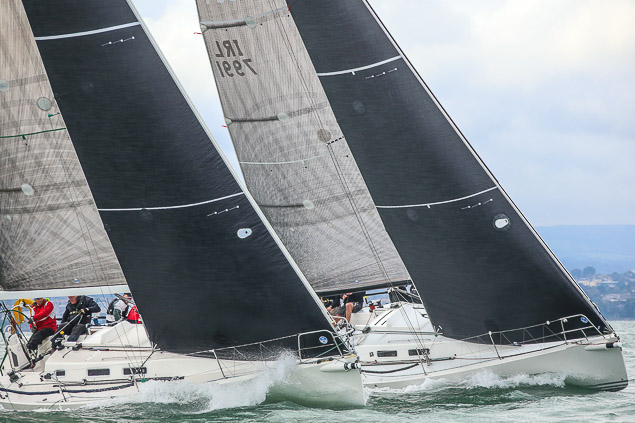 Serious stuff. The J/109s are providing some of the closest racing on Dublin Bay. Photo: Afloat.ie
Serious stuff. The J/109s are providing some of the closest racing on Dublin Bay. Photo: Afloat.ie
Serious stuff perhaps, but while the J/109s are indeed serious in their competition, they look forward to their après sailing with all the enthusiasm of their top class. This weekend’s programme is both user-friendly in terms of time use and event design, and with sponsorship from the Porter House of Dingle Gin fame, plus North Sails and UK Sails and Kraken Rum, there’s every chance of quite a party in the Royal Irish YC tonight.
But they have to be serious in the sociability control area, for tomorrow morning with three races scheduled they’re going to have the addition experience of being video-coached by Prof O’Connell of North Sails, and as was discovered when he came to Howth recently with RIB and camera, he takes no prisoners when making his comments…..
 Intensive coaching – The Prof calls it as he sees it on Chimaera’s headsail. Photo: Afloat.ie
Intensive coaching – The Prof calls it as he sees it on Chimaera’s headsail. Photo: Afloat.ie
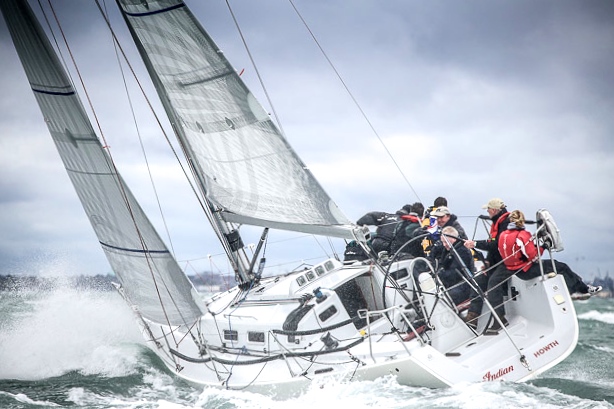 Finding their feet. Indian from Howth (Colm Buckley & Simon Knowles) is one of the more recent additions to the class. Photo: Afloat.ie
Finding their feet. Indian from Howth (Colm Buckley & Simon Knowles) is one of the more recent additions to the class. Photo: Afloat.ie
With the success of Storm, Howth is seeing extra J/109 interest, and today’s fleet with include the peninsula port’s J/109 Indian (Colm Buckley & Simon Knowles), acquired last year from the ready pool of used J/109s available in the Solent area, while the busy fleet in the Irish Sea may have suffered the loss of Nigel Ingrams’ Just Jay in the destruction of Holyhead Marina in Storm Emma on March 1st, but he has leapt onto another horse with the acquisition of sister-ship Jetstream from Pwllheli.
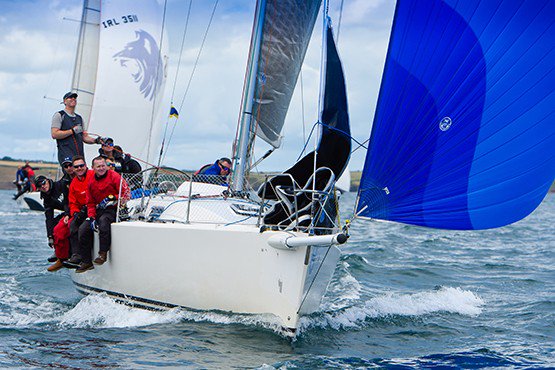 John Maybury’s J/109 Joker 2 (RIYC) skippered by Commandanat Barry Byrne, was the first winner of the Beaufort Cup at Volvo Cork Week 2016. Photo: Bob Bateman
John Maybury’s J/109 Joker 2 (RIYC) skippered by Commandanat Barry Byrne, was the first winner of the Beaufort Cup at Volvo Cork Week 2016. Photo: Bob Bateman
However, the final word on the special attraction of the J/109 for sailing in the Dublin area deserves to be left with current class captain Andrew Craig, whose Chimaera will be one of the favourites for this weekend’s championship:
“The attraction is the diversity. Every so often we come together as a One-Design class as is seen this weekend, yet even this associates us fully in another classic with the Dublin Bay SC Saturday coastal race, as does the Wave Regatta with the Lambay Race at Howth. Only the Nationals are a total stand-alone event. At other times, everyone has their other interests which can be successfully incorporated into each boat’s preferred seasonal programme. Everything from the Nationals to the Beaufort Cup in Volvo Cork Week (won in 2016 by John Maybury’s J/109 Joker II skippered by Commandant Barry Byrne), to the Round Ireland or the Dun Laoghaire to Dingle Races or Calves Week or the Scottish Series, or cruising to West Cork and Kerry or the Lambay Race back on the East Coast– you’ll find our J/109s are doing these things as a class or on their own initiative. It makes for extremely interesting sailing sport with a wonderful diversity of people. And most of it is all happening very conveniently just down the road.”
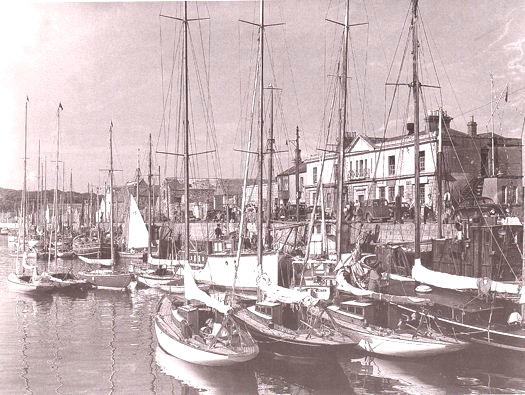 Historic precedent. The Dublin Bay 24s at Howth Regatta in 1954. Their successors the J/109s are featuring the Wave Regatta at Howth from 1st to 3rd June in their 2018 programme. Photo courtesy HYC.
Historic precedent. The Dublin Bay 24s at Howth Regatta in 1954. Their successors the J/109s are featuring the Wave Regatta at Howth from 1st to 3rd June in their 2018 programme. Photo courtesy HYC.
Irish J109 Cruiser–Racer Fleet Continues to Rise
Last October there were 15 boats at the Irish J109 National Championships, a very impressive turnout for a 35–foot Cruiser Racer. What's more 109s have won ISORA overall in the last three seasons and filled the first four places last year and the ICRA Championships for the last three years. Afloat.ie asked newly elected class captain, Andrew Craig, a veteran of the International Dragon circuit, what he puts this success down to.
The J109 class now has more boats racing than ever and it is continuing to grow. We are developing a community and collegiate spirit in the class. The 109 is a great all round performer in virtually all conditions and points of sailing and it is durable and easily handled which is critical and we are distinctive in having mixed crews of all ages with different ability with great racing throughout the fleet whether we are racing in cruiser classes or under our one design rules. The largest fleet is in Dun Laoghaire with 13 while there are boats based in Howth, Poolbeg, Crosshaven and Kinsale. We also work closely with the Welsh boats.
 New J109 class captain Andrew Craig at the helm of Chimaera. Photo: Afloat.ie
New J109 class captain Andrew Craig at the helm of Chimaera. Photo: Afloat.ie
ISORA Victories
Andrew feels that the 109 is one of the best 35 foot cruiser racers ever designed and is particularly suited to sailing in Irish and UK waters. It is a very well built boat with a good resale value, a fast cruiser, well appointed and laid out below with full standing headroom and at the same time it is the most competitive 35 footer under IRC across the range. The results prove the point, 109s have won ISORA overall in the last 3 seasons and filled the first 4 places last year, the ICRAs for the last 3 years, and also in 2017 a class win in the Scottish series in Tarbert, overall win in the Volvo Dun Laoghaire Regatta as well as podium places in the Dun Laoghaire Dingle Race, Sovereigns Regatta and Calves Regatta.
 Welsh J109 Mojito (Vicky Cox and Peter Dunlop) are ISORA champions. Photo: Afloat.ie
Welsh J109 Mojito (Vicky Cox and Peter Dunlop) are ISORA champions. Photo: Afloat.ie
The local racing is terrific and in Dublin Bay, the J109s have the best of all worlds racing under 3 systems ECHO, IRC and Scratch which means there is competition amongst the whole fleet.
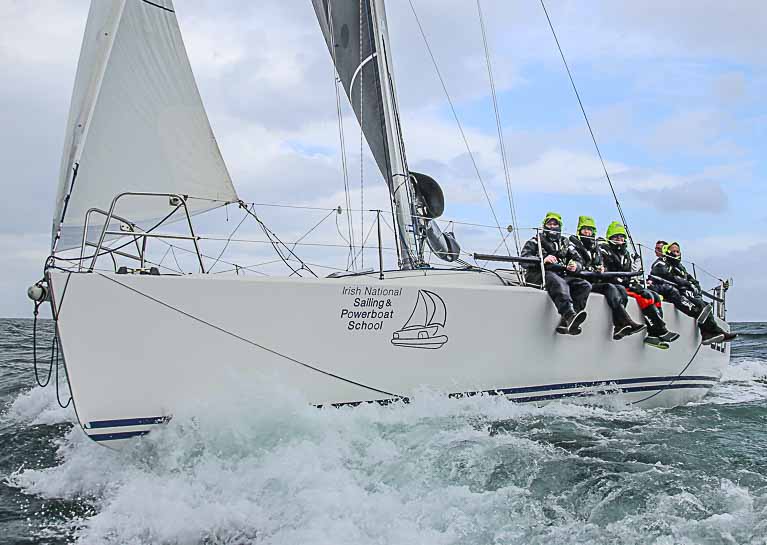 INSS Sailing School 109, Jedi skippered by Kenny Rumball. Photo: Afloat.ie
INSS Sailing School 109, Jedi skippered by Kenny Rumball. Photo: Afloat.ie
Andrew also makes the point that while the class has some very strong teams prize winners are well spread out across the fleet. In the travelling events a number of different boats featured while in Dublin Bay 5 different 109s won trophies in the DBSC Class 1 Series and in the Class series run within the DBSC results 6 different boats won trophies.
J109s Commited to DBSC Cruiser One
We are often asked whether we should have our own class in Dublin Bay however we are fully committed to supporting the Cruiser 1 Class under the DBSC flag. We strongly believe that this is in the best interests of both DBSC and our class. However given the size of our fleet some regattas are now offering additional prizes for the J109 fleet within the Class 1 results. We have our own National Championship under class rules and this year, for the first time, we will hold an East Coast Championship and the date has been carefully chosen to be between two ISORA races to allow maximum participation by the Welsh boats.
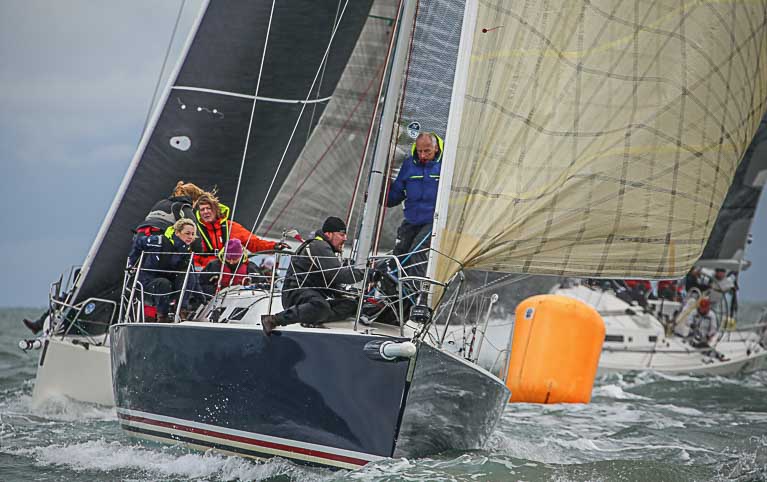 The 109 is a great all round performer in virtually all conditions and points of sailing
The 109 is a great all round performer in virtually all conditions and points of sailing
J109 Nationals For Howth Yacht Club
Our Nationals will be held in Howth Yacht Club to acknowledge new members based there and also to recognise that the Kelly family in Storm, who are based in Howth, have been huge supporters of the class over the last 10 years and, of course, they are National Champions for the last two years. The rest of the fleet looks forward to beating them in 2018 in their home waters!
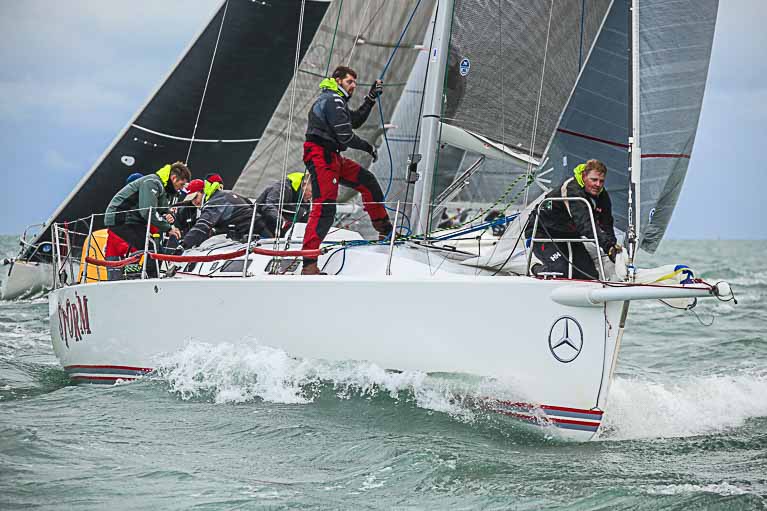 The Kelly family in Storm, who are based in Howth, are Scottish Series winners. Photo: Afloat.ie
The Kelly family in Storm, who are based in Howth, are Scottish Series winners. Photo: Afloat.ie
A strong collegiate spirit has developed with lots of sharing of ideas not only on how to race faster but also on how to move forward on a collective basis. Andrew said he was very impressed that virtually every Irish J109 was represented at the recent AGM and there were very good discussions on a wide range of topics including development plans, events, social activity, training weekends, video de-briefings after racing, identity building, class rules, managing the overall cost of sailing and there is great commitment to continued development of the class.
 J109 racing at the 2017 National Championships. Photo: Afloat.ie
J109 racing at the 2017 National Championships. Photo: Afloat.ie
Take your Granddaughter for a Potter on a J109
Afloat.ie asked Andrew, after competing all over the world in the Dragon at the highest level, why did he chose the J109?
Andrew said that he joined the class for all the reasons discussed during our conversation, however if he was to summarise he would say he wanted a boat that he could sail and race with his wife, sons and friends and the boat had to be competitive and provide good racing locally with the opportunity to travel to away events and that he could take his granddaughter out safely for a potter in Dublin Bay. In addition he got a fast well built and fully appointed cruising boat into the bargain.




























